
- Home
- Travel Packages
- Top Destination
-
Travel Attraction
By Category
Top Attraction

- Travel Agents
- Car Rentals
- Hotels
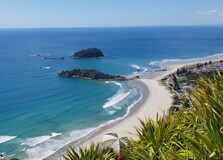
Mount Maunganui (Māori: Mauao) is a vibrant coastal suburb and iconic landmark in Tauranga, Bay of Plenty, New Zealand. The distinct 232 m dormant volcanic cone sits at the end of a tombolo, with both ocean and harbour beaches on either side :contentReference[oaicite:1]{index=1}. Known simply as "The Mount," it offers a perfect mix of natural beauty, adventure, and relaxed beach-town culture. How to Reach Mount Maunganui, Bay Of Plenty By Car: Just a 10-minute drive from Tauranga via the Harbour Bridge via the Bay Link, or around 1 hour from Rotorua and ~2¾ hours from Auckland :contentReference[oaicite:2]{index=2}. By Bus: Regional and local buses run from Tauranga to Mount Main Street, with frequent MyRide services. By Air: Fly into Tauranga Airport (just south of Mount), then take a taxi or shuttle for the 5-minute ride. Weather at Mount Maunganui The region enjoys a pleasant, temperate climate. Summers (Dec–Feb) are warm and sunny (25–30 °C), ideal for the beach and outdoor activities :contentReference[oaicite:3]{index=3}. Winters (Jun–Aug) are mild (10–18 °C), but rainfall increases. Autumn and spring are mild and less crowded, making them ideal for exploring. Timings of Mount Maunganui As a suburb and outdoor destination, Mount Maunganui is open 24/7. Specific attractions have their own hours: Mount Hot Pools: Daily, typically 8:00–20:00. Beach Patrols: Lifeguards on main ocean beach seasonally (Nov–Mar). Harbour and walking tracks: Always open. Why Mount Maunganui is Famous - Two beautiful beaches: Surf Beach on the ocean side; calm Pilot Bay on harbour side, both within walking distance :contentReference[oaicite:4]{index=4}. - Mauao summit: The extinct volcanic cone with hiking trails offering panoramic 360° views of plains, sea, and Tauranga :contentReference[oaicite:5]{index=5}. - Ocean pools: The famed Mount Hot Pools feature hot saltwater baths—perfect after a hike or surf :contentReference[oaicite:6]{index=6}. - Community & events: Hosts beach events, triathlons, markets, and the Northern Regional Surf Championships :contentReference[oaicite:7]{index=7}. Entry and Visit Details - Free access: The summit walk, beaches, harbour-side walks, and island tracks are free. - Parking: Paid street and zone parking along Main Beach; early arrival is recommended during summer. - Hot Pools admission: Approx. NZD 14 per person; passes available on-site :contentReference[oaicite:8]{index=8}. - Safety: Swim between flags on patrolled ocean beach; watch for harbor boat traffic at Pilot Bay. History & Geography of Mauao Mauao is a rhyolite lava dome formed around 2.35 Ma ago—as a result, Mount Maunganui was born. It holds deep cultural significance to local iwi, Ngāi Te Rangi, Ngāti Ranginui and Ngāti Pūkenga, who co-manage its summit with the Tauranga City Council :contentReference[oaicite:9]{index=9}. Legend tells of a nameless mountain that, spurned in love, was dragged to the sea by patupaiarehe (supernatural beings), earning the name "Mauao" meaning “caught by the dawn sun” :contentReference[oaicite:10]{index=10}. The Waka landing—used by Māori for centuries—tells the story of early settlement and spiritual importance. Architecture & Urban Design Mount Maunganui’s beachfront area features a relaxed, sun-soaked streetscape with low-rise boutique shops, cafés, surf stores, and eateries lining The Strand. Pilot Bay’s wharf is a community hub with a mix of heritage buildings and seaside facilities :contentReference[oaicite:11]{index=11}. Notable modern sites include the Bay Oval cricket stadium and Tauranga Airport terminal near the Mount suburb :contentReference[oaicite:12]{index=12}. Things to Do at Mount Maunganui - Hike Mauao summit: Easy–moderate trails (30–40 min) with breathtaking views :contentReference[oaicite:13]{index=13}. - Base walk: Scenic 3.5 km loop around the hill—ideal for walking and jogging :contentReference[oaicite:14]{index=14}. - Surf & swim: Surfboards to rent; lessons available. Swim in calm Pilot Bay or on surf beach :contentReference[oaicite:15]{index=15}. - Hot Pools: Saltwater pools ranging 31–39 °C, plus spa jets and family-friendly zones :contentReference[oaicite:16]{index=16}. - Moturiki Island: Walk accessible at low tide, enjoy birdwatching, and view blowhole :contentReference[oaicite:17]{index=17}. - Cycle & stroll: Beachfront paths are shared by bikes and walkers :contentReference[oaicite:18]{index=18}. - Stand-up paddleboarding: Lessons and rentals available—calm harbour waters suit beginners :contentReference[oaicite:19]{index=19}. - Boat cruises: Dolphin, fishing, and scenic cruises depart from Pilot Bay :contentReference[oaicite:20]{index=20}. - Art & nightlife: Browse beachside galleries, street murals; enjoy bars and summer markets :contentReference[oaicite:21]{index=21}. - Attend events: Northern Surf Champs, triathlons, concert series, farmers’ markets. Interesting Facts - Mauao experienced a tragic ship accident in 1950 when the "Ranui" ferry sank off its base—memorial plaque exists :contentReference[oaicite:22]{index=22}. - The ocean beach has been ranked New Zealand’s #1 beach by TripAdvisor and recognized globally :contentReference[oaicite:23]{index=23}. - Bay Oval opened in 2007 and hosted its first Test match in 2019; capacity ~10,000 :contentReference[oaicite:24]{index=24}. - The Mount is a surf mecca and triathlon hotspot, with international championships held regularly :contentReference[oaicite:25]{index=25}. - Moturiki was once a Marineland aquarium (1950s–1980s), now a wildlife refuge :contentReference[oaicite:26]{index=26}. Tips for Visiting Mount Maunganui Start the summit hike early—sunrise is spectacular, and the route can get busy :contentReference[oaicite:27]{index=27}. Bring water, sunscreen, and layers—weather can change on summit. Arrive early for parking or use Tauranga bus or cycle to avoid summer crowds :contentReference[oaicite:28]{index=28}. Book Hot Pools online during high season to secure your spot :contentReference[oaicite:29]{index=29}. Stay between flags on patrolled surf beach and follow lifeguard guidance. Don’t miss local ice-cream (Sea People, Mount Made, Copenhagen Cones) :contentReference[oaicite:30]{index=30}. Explore street art & galleries along The Strand; consider guided walking tours of Māori legend sites. Try paddleboarding or kayak around Pilot Bay or Moturiki island—sunset tours are magical :contentReference[oaicite:31]{index=31}. Time your visit to coincide with community events and markets—Little Big Markets, artisan nights).
Explore More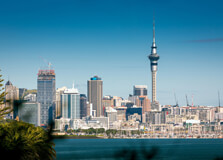
The Sky Tower in Auckland is one of New Zealand’s most iconic landmarks, offering visitors stunning panoramic views of the city and beyond. Standing at 328 meters (1,076 feet), it is the tallest freestanding structure in the Southern Hemisphere and a must-see attraction for anyone visiting Auckland. Whether you are an adventure seeker looking to experience its thrilling activities, or simply a tourist wanting to take in the breathtaking views, the Sky Tower offers something for everyone. In addition to its incredible views, the tower features restaurants, observation decks, and exciting activities like bungee jumping and skywalking, making it a top destination in Auckland. How to Reach Sky Tower Auckland, Auckland The Sky Tower is centrally located in downtown Auckland, making it easily accessible from various parts of the city. The address is Victoria Street West, Auckland CBD. If you're traveling by car, there are multiple parking options available in the area, including underground parking at the Sky Tower. You can also reach the tower using public transport. Auckland has an efficient public transport system, including buses and trains, which connect various parts of the city to the tower. The nearest bus stop is located just a short walk away from the Sky Tower, and the Auckland train station is around a 10-minute walk. Taxis and ride-sharing services like Uber are also commonly used by visitors. Weather Auckland experiences a temperate climate, which means it enjoys mild and pleasant weather year-round, making it an ideal destination at any time of the year. Summer (December to February) temperatures range between 20°C to 25°C (68°F to 77°F), while winter (June to August) temperatures hover between 8°C to 15°C (46°F to 59°F). The weather is generally calm, but occasional showers can be expected, especially in the winter months. If you plan on visiting the Sky Tower, it is recommended to check the weather forecast for the day of your visit, as clear skies will provide the best views from the observation decks. The tower also provides an indoor viewing area in case of inclement weather. Timing The Sky Tower is open every day of the week, typically from 9:00 AM to 10:00 PM, with extended hours during peak tourist seasons. The last entry is usually around 9:30 PM, so it is recommended to arrive earlier if you want to enjoy the views for a longer period. However, hours may vary depending on the time of year or special events, so it is always a good idea to check the Sky Tower website for the most up-to-date information. The tower can get particularly busy during holidays and weekends, so visiting early in the day is advisable for a more relaxed experience. Why Famous for Sky Tower Auckland, Auckland? The Sky Tower is famous for being the tallest freestanding structure in the Southern Hemisphere, offering visitors unrivaled views of Auckland. The tower’s 360-degree observation deck provides a bird’s-eye view of Auckland’s harbor, volcanoes, and surrounding islands. It’s also famous for its thrilling adventure activities, such as the SkyJump and SkyWalk, which attract adrenaline enthusiasts from around the world. The Sky Tower has become synonymous with Auckland’s skyline and is visible from nearly every corner of the city. It is often featured in media and postcards, making it one of the most photographed landmarks in New Zealand. Entry and Visit Details about Sky Tower Auckland, Auckland Visitors to the Sky Tower need to purchase an entry ticket to access the observation deck and other attractions. There are different pricing options depending on the type of experience you wish to have. For a general visit to the observation deck, tickets for adults range between NZD 32 to NZD 38, while tickets for children (5 to 15 years old) are typically NZD 15 to NZD 20. There are also family passes available for those visiting with children. If you wish to experience the SkyJump or SkyWalk, these activities come at an additional cost, with prices starting at NZD 200 for the SkyJump and NZD 150 for the SkyWalk. The prices may vary depending on promotions and time of year, so it’s a good idea to check the official website for current rates. The entry fee provides access to the observation deck, where you can enjoy the views, take in the interactive displays, and shop for souvenirs at the Sky Tower gift shop. History and Architecture The Sky Tower was completed in 1997 and was designed by the architectural firm Craig Craig Moller. The structure is made of reinforced concrete and steel and took about 2 years to build. The Sky Tower was initially constructed as part of the SkyCity entertainment complex, which includes a casino, hotel, and restaurants. The tower serves not only as a tourist attraction but also as a communications hub, with its antenna used for television and radio transmission. The architectural design of the Sky Tower is sleek and modern, with a design that incorporates a spire at the top, which gives it a unique silhouette in the Auckland skyline. The observation deck is located 220 meters (722 feet) above the ground, while the tower's antenna reaches a height of 328 meters (1,076 feet), making it the tallest structure in New Zealand. The Sky Tower’s glass-floored observation deck is a highlight for visitors, providing a thrilling view of the ground below as well as panoramic views of Auckland's landmarks. Things to Do at Sky Tower Auckland, Auckland There are plenty of exciting activities to enjoy at the Sky Tower, making it a must-visit for anyone in Auckland. Some of the top things to do include: Observation Deck: Visit the 360-degree observation deck to enjoy sweeping views of Auckland, including the harbor, islands, and nearby volcanoes. On a clear day, visitors can see as far as the Coromandel Peninsula and the Waiheke Islands. SkyJump: If you're an adrenaline junkie, the SkyJump is a must-try. It's a thrilling 192-meter (630 feet) bungy-like jump off the tower, providing an exhilarating freefall experience. The jump is safe, and the staff ensures that all safety precautions are followed. SkyWalk: For those who prefer a less extreme experience but still want a challenge, the SkyWalk is an exciting walk around the outer edge of the tower’s observation deck. You’ll be securely harnessed as you take in the views of the city below. Dining at the Orbit Restaurant: Located 190 meters above ground, the Orbit Restaurant offers a fine dining experience with 360-degree views of the city. The restaurant revolves slowly, allowing guests to enjoy a constantly changing view as they dine. Souvenir Shopping: The Sky Tower has a gift shop where you can purchase a variety of souvenirs, from postcards to Sky Tower-themed memorabilia. It's a great place to pick up a memento of your visit. Facts About Sky Tower Auckland, Auckland The Sky Tower stands at 328 meters (1,076 feet) tall, making it the tallest freestanding structure in the Southern Hemisphere. The observation deck is located at a height of 220 meters (722 feet), and visitors can experience 360-degree panoramic views. The Sky Tower weighs approximately 15,000 tons. It is a key part of the SkyCity complex, which includes a casino, restaurants, and a hotel. The SkyJump is one of the only urban jumps in the world that allows visitors to jump from a tower. On clear days, visitors can see up to 80 kilometers in the distance from the observation deck. Tips for Visiting Sky Tower Auckland, Auckland Plan your visit around sunset for the best views of the city as it transitions from day to night. Wear comfortable shoes if you plan to take part in the SkyWalk or other activities. Bring a camera to capture the stunning views from the observation deck. If you're visiting with children, check for any family promotions or discounts. Check the weather forecast before your visit for the clearest views. Book your SkyJump or SkyWalk experience in advance, as these activities are popular and often require reservations.
Explore More
The Auckland War Memorial Museum is one of New Zealand's most significant cultural institutions, located in the heart of Auckland Domain, one of the city's largest parks. The museum serves as a place to honor New Zealand's military history and those who have served in wars. It is also a major center for the preservation of the country's natural and cultural heritage, with extensive exhibits on Maori and Pacific Island cultures, as well as New Zealand's natural history. Visitors can enjoy both educational and emotional experiences at this impressive museum, which offers a perfect blend of history, art, and science. How to Reach Auckland War Memorial Museum, Auckland The Auckland War Memorial Museum is located in the Auckland Domain, which is approximately 2 kilometers (1.2 miles) from Auckland's city center. The easiest way to reach the museum is by public transport, including buses that operate frequently from various parts of the city. Several bus routes pass by the Auckland Domain, and the nearest bus stop is just a short walk from the museum entrance. Additionally, the museum is well-served by taxis and ride-sharing services like Uber. For those driving, there is parking available in the Auckland Domain, but it can be limited, especially during busy times. Walking from the city center to the museum is also an option, with a leisurely 20-minute walk through the beautiful Auckland Domain park. Weather Auckland enjoys a temperate maritime climate, meaning that it experiences mild temperatures throughout the year. Summer (December to February) temperatures in Auckland typically range from 20°C to 25°C (68°F to 77°F), while winter (June to August) temperatures range between 8°C and 15°C (46°F to 59°F). Rain is common year-round, so it’s advisable to bring a light jacket or umbrella, especially during the cooler months. If you're visiting the Auckland War Memorial Museum, checking the weather forecast before your trip will help you dress accordingly. The museum is indoors, so you can always enjoy a warm, dry experience while exploring its exhibits regardless of the weather outside. Timing The Auckland War Memorial Museum is open every day of the year, with the typical operating hours from 10:00 AM to 5:00 PM. During public holidays or peak tourist seasons, the museum may extend its opening hours or have special events. However, it is always best to check the museum's official website for the most up-to-date details on hours and any holiday closures. The museum offers free entry to New Zealand residents, while international visitors are required to purchase an entry ticket. The museum can get busy during weekends and school holidays, so visiting during weekdays or earlier in the day may provide a more relaxed experience. Why Famous for Auckland War Memorial Museum, Auckland? The Auckland War Memorial Museum is famous for its dual role as both a war memorial and a museum dedicated to New Zealand’s cultural and natural history. It serves as a tribute to those who have served in various wars, especially the World Wars. The museum houses an impressive collection of military memorabilia, including war medals, uniforms, weapons, and personal stories that bring the country's wartime history to life. The museum is also renowned for its extensive collections related to Maori and Pacific Island cultures, offering insight into New Zealand’s indigenous people and their rich traditions. Additionally, the museum is famous for its stunning architecture, which combines classical and modern elements, and for the breathtaking views it offers of Auckland and the surrounding area from its location in the Auckland Domain. It is considered one of the finest museums in New Zealand and is a popular stop for tourists and locals alike who wish to understand more about the country’s history, people, and natural world. Entry and Visit Details about Auckland War Memorial Museum, Auckland Entry to the Auckland War Memorial Museum is free for New Zealand residents and citizens, making it an affordable attraction for local visitors. International visitors are required to pay an entry fee, with prices typically ranging from NZD 25 to NZD 30 for adults, while children aged 14 and under generally enter for free. The museum also offers discounted tickets for seniors and students. Some special exhibits may have a separate entry fee, and it is advisable to check in advance if you are interested in any of these temporary exhibitions. The museum also provides free entry to its permanent collections, which makes it a great value for those wishing to explore the history and culture of New Zealand at their own pace. History and Architecture The Auckland War Memorial Museum was established in 1852 as the Auckland Museum, and it initially focused on New Zealand’s natural history. It moved to its current location in the Auckland Domain in 1929 and was renamed the Auckland War Memorial Museum to honor those who served in World War I and subsequent wars. The museum's building was designed by architect Gummer and Ford and features a neoclassical architectural style with a striking facade and grand columns. The building's central hall is topped with a large dome, which houses the museum’s iconic memorial to New Zealand’s fallen soldiers. Over the years, the museum has undergone several renovations and expansions, including the addition of modern wings and updated exhibit spaces. The museum’s design cleverly incorporates elements of both classical architecture and modern design, making it both a tribute to the country’s past and a symbol of New Zealand’s progress. The location of the museum within the expansive Auckland Domain also provides beautiful surroundings and a scenic view of the city, making it a perfect spot for visitors to enjoy both the indoor and outdoor spaces. Things to Do at Auckland War Memorial Museum, Auckland There are many things to see and do at the Auckland War Memorial Museum, making it a great destination for visitors of all ages. Some of the key highlights include: Explore the War Memorial Hall: The War Memorial Hall houses a large collection of artifacts from New Zealand's involvement in various wars, including World War I, World War II, and more recent conflicts. The hall is a moving tribute to those who served and died in these wars. Visit the Maori and Pacific Island Exhibits: The museum features an impressive collection of Maori and Pacific Island artifacts, including traditional clothing, tools, and artwork. Learn about the indigenous cultures of New Zealand and the Pacific region. Natural History Exhibits: Discover the diverse flora and fauna of New Zealand through exhibits on the country’s unique wildlife, including its bird species, reptiles, and marine life. Interactive Exhibits: The museum offers various interactive displays that allow visitors to engage with the exhibits, from virtual reality experiences to hands-on activities for children. Attend Special Exhibitions: The museum regularly hosts temporary exhibitions covering a variety of topics, from contemporary art to international history. Be sure to check for any special exhibits during your visit. Enjoy the Auckland Domain: After exploring the museum, take a stroll through the Auckland Domain, one of the city’s largest and most beautiful parks. It’s a great place to relax and enjoy nature. Facts About Auckland War Memorial Museum, Auckland The Auckland War Memorial Museum is one of the oldest museums in New Zealand, established in 1852. It is located in the Auckland Domain, a park that was established in 1841 and is one of the city's oldest public spaces. The museum's War Memorial Hall houses over 20,000 war-related items, making it a key site for learning about New Zealand's military history. The museum's collection includes over 2.5 million objects, making it one of New Zealand’s largest and most comprehensive museums. The museum is home to one of the largest collections of Maori and Pacific Island artifacts in the world. Tips for Visiting Auckland War Memorial Museum, Auckland Wear comfortable shoes, as you will likely spend a few hours exploring the museum’s multiple floors and exhibits. Consider purchasing a combination ticket that includes access to both the museum and any special exhibitions for a more comprehensive experience. If you're visiting with children, check out the museum's family-friendly programs and interactive exhibits. Take a break in the museum's café, where you can relax and enjoy a meal while taking in views of the Auckland Domain. Take time to visit the museum’s gift shop, where you can purchase unique souvenirs related to New Zealand’s history and culture. Check the museum's website for details on any special events or temporary exhibitions that might be taking place during your visit.
Explore More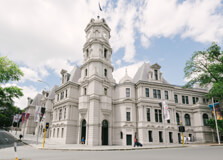
The Auckland Art Gallery Toi o Tāmaki is one of New Zealand's premier art institutions, located in the heart of Auckland's central business district. As the largest public art gallery in New Zealand, it houses an impressive collection of national and international art, ranging from traditional Maori works to contemporary masterpieces. Whether you're an art lover or simply looking to explore Auckland’s cultural scene, the Auckland Art Gallery offers a vibrant space to appreciate the creative diversity of the country. With stunning architecture, rotating exhibitions, and a strong commitment to showcasing both New Zealand’s heritage and modern artistic expression, it is a must-see for anyone visiting Auckland. How to Reach Auckland Art Gallery, Auckland The Auckland Art Gallery is located at 36 Kitchener Street, near the central business district of Auckland. It's easily accessible by a variety of transport options. Public transport options are plentiful, with many buses stopping nearby. The gallery is also a short walk from the Auckland Train Station, which connects commuters from various parts of the city. If you're traveling by car, there are parking facilities close to the gallery, including a paid car park beneath the Auckland Civic Theatre. Additionally, the gallery is close to the popular Queen Street, making it an easy walk from many central Auckland locations. You can also take a taxi or use ride-sharing services like Uber for more convenience. Weather Auckland has a temperate maritime climate, characterized by mild temperatures throughout the year. Summer months (December to February) are warm, with temperatures typically ranging from 20°C to 25°C (68°F to 77°F), while winter (June to August) brings cooler conditions with temperatures ranging from 8°C to 15°C (46°F to 59°F). The city experiences moderate rainfall throughout the year, so it’s a good idea to carry an umbrella or light jacket if you’re visiting during the wetter months. Regardless of the weather, the Auckland Art Gallery is an indoor experience, so you can enjoy the exhibitions and collections in comfort, rain or shine. Timing The Auckland Art Gallery is open daily from 10:00 AM to 5:00 PM. During public holidays or peak tourist seasons, the gallery may extend its hours or have special events. The gallery is closed on Christmas Day but remains open on other major holidays. It’s advisable to check the gallery's official website for any changes to operating hours or special holiday events before planning your visit. For visitors wishing to avoid crowds, it’s often best to visit on weekdays or early in the morning. Why Famous for Auckland Art Gallery, Auckland? The Auckland Art Gallery is renowned for its extensive collection of both historical and contemporary art. It is particularly famous for its representation of New Zealand’s art history, including significant works from the colonial period, early New Zealand modernism, and Maori and Pacific Island art. The gallery's permanent collection showcases masterpieces from some of New Zealand's most renowned artists, including works by Charles Frederick Goldie, Frances Hodgkins, and Colin McCahon. Additionally, the gallery is known for hosting world-class temporary exhibitions, bringing in international artists and traveling exhibitions. The combination of New Zealand heritage art and global contemporary art makes the gallery a vibrant, ever-changing space. The architecture of the building itself is also a major attraction. The Auckland Art Gallery was expanded and renovated in 2011, and the design blends heritage and modern elements seamlessly. The gallery’s award-winning design includes a beautiful glass roof that allows natural light to flood the space, enhancing the experience for visitors. Entry and Visit Details about Auckland Art Gallery, Auckland Entry to the Auckland Art Gallery is free for all New Zealand residents, which is a significant draw for locals. International visitors will need to purchase an entry ticket, which typically costs around NZD 20 for adults. There are often discounted prices for seniors, students, and children. The gallery also offers special promotions and free entry on certain days or for specific exhibitions, so it's a good idea to check the gallery's website or social media pages for any upcoming offers or changes in pricing. Group discounts are available for schools or large tours, and the gallery is well-equipped for visitors with accessibility needs, including wheelchair access throughout the building. History and Architecture The Auckland Art Gallery was first opened in 1888 and has since become a key cultural institution in New Zealand. Originally designed by architect Sir George Grey, the building has undergone multiple expansions and renovations over the years. The most significant renovation took place in 2011 when the gallery was redesigned by architects from the firm Mee + O’Connell and constructed by the public architecture practice, providing a more modern and functional space. The renovation preserved the heritage aspects of the original building while adding contemporary design features, like the distinctive glass canopy that now crowns the gallery, allowing natural light to flood the central atrium. The gallery’s architecture beautifully combines old and new, with the original building's neoclassical style complementing the modern addition, creating a harmonious space that suits its vast range of collections. The unique layout and thoughtful design make the museum an architectural gem in the heart of Auckland. The museum is also located within the Auckland Domain, a large public park that provides lovely green spaces and great views of the surrounding area, offering visitors a scenic backdrop for their museum experience. Things to Do at Auckland Art Gallery, Auckland There is no shortage of things to do when visiting the Auckland Art Gallery, whether you’re interested in exploring the extensive art collections, engaging with special exhibitions, or enjoying the architectural beauty of the building itself. Some of the highlights include: Explore the Permanent Collection: The gallery’s permanent collection includes works by significant New Zealand artists, such as Charles Goldie, and a wide range of international artists. The collection covers a variety of genres, including landscape painting, contemporary art, and traditional Maori art. Attend Special Exhibitions: The gallery regularly hosts special exhibitions showcasing both international and New Zealand-based artists. These exhibitions often feature cutting-edge contemporary art, photography, sculpture, and installations, making each visit a new experience. Participate in Events and Workshops: The Auckland Art Gallery frequently hosts artist talks, workshops, and other educational events for visitors of all ages. This is a great way to engage more deeply with the artwork and learn from experts in the field. Enjoy the Outdoor Sculpture Collection: The gallery is home to a large collection of sculptures located in the surrounding Auckland Domain, offering a pleasant outdoor experience as you explore the gallery’s extensive grounds. Relax at the Café: After exploring the gallery, take a break at the gallery’s café, which offers a range of delicious food and drinks with views over the park. Facts About Auckland Art Gallery, Auckland The Auckland Art Gallery Toi o Tāmaki is the largest public art gallery in New Zealand. It houses over 15,000 works of art, including an impressive collection of New Zealand and Pacific art, as well as international art from Europe, Asia, and the Americas. The gallery’s building is a blend of neoclassical and contemporary architecture, with an iconic glass canopy that allows natural light to fill the space. It regularly hosts special exhibitions that bring international artists to New Zealand, making it a key venue for contemporary art in the region. The Auckland Art Gallery is an award-winning architectural space, having received numerous design awards for its renovation and expansion. Tips for Visiting Auckland Art Gallery, Auckland Wear comfortable shoes, as the gallery is spacious, and you’ll want to explore the various floors and exhibitions. Check out the gallery’s website before your visit for information about any special exhibitions or events happening during your stay. If you’re traveling with children, look for family-friendly workshops or activities offered by the gallery. Consider taking a guided tour to gain deeper insights into the art and architecture of the gallery. Take time to relax in the museum’s café, which is a great place to take a break and reflect on what you’ve seen. Visit the Auckland Domain park for a leisurely stroll before or after your visit, as it provides a peaceful and scenic environment.
Explore More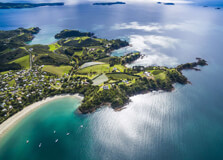
Waiheke Island, located just 35 minutes by ferry from downtown Auckland, is a beautiful escape from the city. Known for its picturesque beaches, rolling vineyards, and laid-back atmosphere, Waiheke is one of New Zealand’s most popular island getaways. Visitors are drawn to the island’s stunning natural beauty, its thriving wine industry, and a range of outdoor activities that make it an ideal destination for day trips or extended stays. Whether you're interested in exploring the island’s wineries, relaxing on its pristine beaches, or hiking its scenic trails, Waiheke Island has something to offer everyone. How to Reach Waiheke Island, Auckland Waiheke Island is easily accessible from Auckland city center, and the most common way to get there is by ferry. The ferry departs regularly from the Auckland Ferry Terminal, located at the end of Quay Street. The ferry ride takes approximately 35 minutes and offers stunning views of the Auckland skyline and surrounding waters, making the journey itself a memorable part of the trip. There are also a number of ferry services to Waiheke, operated by Fullers360 and Explore Waiheke, offering frequent sailings throughout the day. If you prefer a more private or unique experience, you can also reach the island by private boat, seaplane, or helicopter, although these options are more expensive than the ferry service. Once you arrive on Waiheke Island, public transport, taxis, or rental vehicles such as cars, scooters, or bicycles are available for further exploration. Weather The climate on Waiheke Island is relatively mild, with temperatures remaining comfortable year-round. The island enjoys a temperate maritime climate, which means warm summers and cool winters. Summer temperatures (December to February) generally range from 20°C to 25°C (68°F to 77°F), making it perfect for outdoor activities like hiking, beach outings, and vineyard tours. Winter (June to August) temperatures typically range from 8°C to 15°C (46°F to 59°F), which is mild compared to other parts of New Zealand, though it can be a bit cooler and rainier. Waiheke Island is generally drier than Auckland, which makes it a fantastic destination for outdoor adventures. However, it is still advisable to carry a light jacket or umbrella, as the weather can change suddenly. For the best experience, summer and spring (September to November) are considered ideal times to visit when the island is in full bloom with beautiful flowers and lush landscapes. Timing Waiheke Island is a year-round destination, but the best time to visit largely depends on what kind of experience you are seeking. The peak tourist season runs from December to February, coinciding with the summer holidays in New Zealand. During this period, the island is more crowded, and many events and festivals take place. If you're planning to visit during these months, it's advisable to book accommodations and ferry tickets in advance. For a quieter and more relaxed experience, consider visiting in the shoulder seasons of spring (September to November) or autumn (March to May). These months offer pleasant weather without the summer crowds. Winter (June to August) is the least popular time to visit, as the weather can be cooler and rainier, but the island is still charming for those who enjoy a more tranquil environment. Why Famous for Waiheke Island, Auckland? Waiheke Island is famous for its breathtaking landscapes, world-class wineries, and artistic vibe. It is known as the “Island of Wine” because of its thriving wine industry, with more than 30 wineries scattered across its rolling hills. The island’s Mediterranean climate makes it an ideal location for growing grapes, and many of its wines have gained international acclaim. Wine tours are one of the most popular activities on the island, with visitors flocking to its vineyards to enjoy tastings and scenic views. Aside from its wineries, Waiheke Island is famous for its stunning beaches, such as Oneroa Beach, Palm Beach, and Onetangi Beach, which are perfect for swimming, sunbathing, and water sports. The island also has a strong arts community, with numerous galleries and craft shops showcasing local artwork, jewelry, and pottery. Additionally, Waiheke’s rugged landscape, featuring hills, forests, and coastal cliffs, offers ample opportunities for hiking, cycling, and nature walks, making it a haven for outdoor enthusiasts. Entry and Visit Details about Waiheke Island, Auckland There are no entry fees for Waiheke Island itself, but you will need to purchase a ferry ticket to get there. The cost of ferry tickets varies depending on the time of day, the ferry company, and whether you are traveling with a vehicle. A standard adult return ferry ticket costs around NZD 40 to 45, and a one-way ticket is typically around NZD 20 to 25. Prices for children and seniors are discounted, and some ferry companies also offer family passes or group discounts. Be sure to check ferry schedules and prices in advance to plan your visit accordingly. Once on the island, you can explore at your own pace. If you plan to visit wineries or join a guided tour, booking in advance is recommended. Many vineyards offer tours that include wine tastings and educational talks about the wine-making process. You can also take a hop-on-hop-off bus tour, which will take you to the island’s key attractions, including its top beaches and wineries. If you’re planning on renting a vehicle, car rentals, scooters, and bicycles are available at the ferry terminal or other locations on the island. History and Architecture Waiheke Island has a rich history that dates back to the early Polynesian settlers and later European colonization. The first Maori people arrived on the island in the 14th century, and evidence of their settlement can still be seen in archaeological sites scattered across the island. Early Maori settlers fished, farmed, and built villages on Waiheke, and their influence is still felt in the island's culture today. After European settlers arrived in the 19th century, Waiheke became an important location for agriculture, particularly for sheep farming and later grape growing. Over time, the island’s population grew, and it became known as a popular holiday destination for Aucklanders. Today, Waiheke Island has a mix of modern architecture and historical buildings, many of which are designed to blend in with the island’s natural environment. There are some beautiful historical sites, such as the old churches, including the St. Peter’s Church in Oneroa, and a number of charming old cottages. The island’s architecture is a reflection of its relaxed and rustic vibe, with many buildings using local materials like wood and stone to complement the surrounding landscapes. Things to Do at Waiheke Island, Auckland Waiheke Island offers an abundance of activities for visitors, making it a great destination for outdoor adventures, relaxation, and cultural exploration. Some of the most popular things to do on the island include: Wine Tasting Tours: Waiheke is famous for its vineyards, and taking a wine tour is a must-do activity. There are many vineyards offering wine tastings and tours, where you can learn about the wine-making process while enjoying scenic views of the island. Beach Hopping: The island has several beautiful beaches, including Oneroa Beach, Onetangi Beach, and Palm Beach, which are perfect for swimming, kayaking, or simply relaxing on the sand. Hiking and Nature Walks: Waiheke Island offers numerous hiking trails that take you through its native forests and along coastal cliffs, providing stunning views of the surrounding ocean and islands. Cultural Exploration: The island is home to several art galleries, craft shops, and cultural events that showcase local artists and artisans. Be sure to visit the Waiheke Community Art Gallery or check out the annual Waiheke Island International Jazz Festival. Water Sports: Waiheke is a great spot for kayaking, paddleboarding, and sailing, and there are rental services available at many of the beaches. Cycling: Rent a bike and explore the island at your own pace. Many bike trails connect the vineyards, beaches, and other attractions on the island. Facts About Waiheke Island, Auckland Waiheke Island is the third-largest island in the Hauraki Gulf, covering 92 square kilometers (35 square miles). The island is home to over 30 vineyards, making it one of New Zealand’s most renowned wine-producing regions. Waiheke Island has a population of around 9,000 people, but this number increases significantly during the summer months. The island is known for its excellent hiking trails, beautiful beaches, and vibrant arts scene. The island has a wide range of accommodations, from luxury resorts to more budget-friendly options like holiday parks and Airbnb rentals. Tips for Visiting Waiheke Island, Auckland Book your ferry tickets in advance, especially during peak tourist seasons. If you plan to visit several vineyards, consider taking a guided wine tour to avoid worrying about transport or drinking and driving. Wear comfortable shoes, as there are many walking trails and hilly areas to explore. Don’t forget to bring sunscreen, a hat, and plenty of water, especially if you’re visiting during the summer months. Consider renting a bike or scooter to get around the island easily, as it’s a great way to explore at your own pace.
Explore More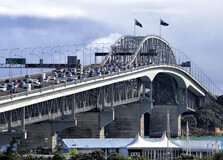
The Auckland Harbour Bridge is one of Auckland's most iconic landmarks and an essential part of the city's transportation infrastructure. Spanning across the Waitematā Harbour, it connects the Auckland Central Business District (CBD) with the North Shore. Not only does it provide vital road access, but it also offers stunning views of the harbor, the city skyline, and the surrounding landscapes. Whether you're commuting or simply exploring the area, the Auckland Harbour Bridge remains a must-see for visitors to Auckland. How to Reach Auckland Harbour Bridge, Auckland The Auckland Harbour Bridge is centrally located, making it easy to access from various parts of the city. If you're traveling by car, it is easily reachable via the Northern Motorway (State Highway 1), which directly leads to the bridge. The bridge itself is located just a short drive from Auckland's city center, about 2 kilometers to the north of the CBD. If you're using public transport, the closest bus stops are located near the bridge, and you can catch a bus from Auckland's CBD that heads towards the North Shore. The Auckland ferry terminal is another nearby option, as ferries often depart from the downtown area to the North Shore, where you can access the bridge by foot or bus. For those looking to walk or cycle, the bridge can also be accessed via the Auckland waterfront, and pedestrian paths run along certain sections. However, if you’re looking for a more immersive experience, many visitors opt for organized walking or cycling tours that provide a closer look at the bridge and surrounding area. Weather at Auckland Harbour Bridge, Auckland The weather in Auckland is generally mild throughout the year, with temperatures rarely reaching extremes. Summers (December to February) are warm, with average highs between 20°C and 25°C (68°F to 77°F), making it an ideal time to enjoy outdoor activities around the bridge, such as walking or sightseeing. The area is often breezy, offering a cool, refreshing atmosphere, particularly when standing on or near the bridge. During winter (June to August), temperatures in Auckland drop to an average range of 8°C to 15°C (46°F to 59°F), but the climate remains relatively temperate. Rain is common in Auckland, especially during the colder months, so it's a good idea to check the weather forecast before planning a visit to the bridge. The breezes near the harbor can make it feel a bit colder, so bringing a light jacket is recommended for winter visits. Timing for Visiting Auckland Harbour Bridge, Auckland The Auckland Harbour Bridge is open for visitors to enjoy year-round. However, the best time to visit is during the daylight hours when you can fully appreciate the panoramic views of the city, the harbor, and the nearby islands. Early mornings and late afternoons are particularly popular times, as these hours offer quieter conditions and opportunities for stunning photographs, especially during the golden hour before sunset. If you're interested in experiencing the bridge at its most iconic, consider visiting on a sunny day. The views from the bridge, especially of the Waitematā Harbour, are especially beautiful under clear skies. For those who enjoy events or thrill-seeking experiences, the bridge often hosts special events such as the Auckland Harbour Bridge Climb and the annual "Bridge to Bridge" fun run. Why Famous for Auckland Harbour Bridge, Auckland? The Auckland Harbour Bridge is famous for several reasons. It is one of the most recognized symbols of the city, offering a striking visual connection between Auckland's central business district and the North Shore. The bridge spans over the Waitematā Harbour, one of the busiest harbors in New Zealand, and its architectural design represents a blend of engineering excellence and aesthetic appeal. Built in 1959, the bridge has become a crucial piece of infrastructure, facilitating the movement of thousands of vehicles daily. Over the years, the bridge has also been involved in several significant engineering projects, including its major expansion in the 1960s to accommodate increasing traffic demand. In addition to its practical significance, the Auckland Harbour Bridge is also known for its breathtaking views and has become a popular tourist attraction. Visitors can enjoy sweeping vistas of the harbor, Rangitoto Island, the Auckland skyline, and the Hauraki Gulf. It also offers a great vantage point for watching ships, yachts, and ferries move across the water. Entry and Visit Details about Auckland Harbour Bridge, Auckland The Auckland Harbour Bridge itself is not a traditional tourist attraction with an entry fee. However, there are several ways to engage with the bridge that offer a more immersive experience. One popular option is the Auckland Harbour Bridge Climb, where visitors can ascend to the top of the bridge and enjoy an unparalleled 360-degree view of the city and surrounding landscapes. This experience is run by a professional team and includes safety equipment and expert guides, making it a thrilling and safe activity for all ages. For those who are interested in exploring the area surrounding the bridge, the nearby waterfront area has plenty of walking and cycling paths, as well as cafes and shops. You can easily access these areas for a more relaxed experience without any additional charges. History and Architecture of Auckland Harbour Bridge The Auckland Harbour Bridge was designed by the renowned New Zealand engineering firm, Freeman Fox & Partners, and built in the 1950s. The project was a significant engineering feat at the time, with the bridge being constructed using a cantilever design. At its completion in 1959, the bridge was considered one of the largest infrastructure projects in the country. The bridge originally had four lanes, but due to growing traffic volumes, an expansion project in the 1960s added more lanes, and it was later reinforced with a steel deck. The design is a remarkable blend of modernism and industrial strength, with the distinctive truss-like structure making the bridge instantly recognizable. Over time, the bridge has undergone several updates to maintain its structural integrity, but it has retained its original design, which remains a testament to mid-20th century engineering. Things to Do at Auckland Harbour Bridge, Auckland There are plenty of things to do around the Auckland Harbour Bridge, both on the bridge itself and in the surrounding area: Auckland Harbour Bridge Climb: One of the most popular activities, where you can climb to the top of the bridge for an incredible view of Auckland. This adventure is available for both tourists and locals and offers a thrilling experience for all ages. Walking and Cycling: The area surrounding the bridge is equipped with pedestrian and cyclist paths, so you can enjoy a leisurely walk or bike ride across the harbor while taking in the views of the bridge and the city. Scenic Views: Whether you're on the bridge itself or exploring the nearby waterfront, the views of the Waitematā Harbour, Rangitoto Island, and the Auckland skyline are incredible. Be sure to bring a camera! Harbour Cruises: You can also take a harbor cruise to get a different perspective of the Auckland Harbour Bridge. Many tours depart from nearby Viaduct Harbour or the Auckland Ferry Terminal. Picnic and Relaxation: The surrounding waterfront area has plenty of green spaces for picnics or just relaxing. There are also various cafes where you can enjoy a meal while watching the bustling harbor activities. Facts About Auckland Harbour Bridge, Auckland The Auckland Harbour Bridge was completed in 1959, making it over 60 years old. It is 1,020 meters long (3,350 feet) and spans across the Waitematā Harbour. The bridge initially had four lanes, but today it accommodates up to eight lanes of traffic. More than 150,000 vehicles cross the bridge daily, making it one of New Zealand's busiest bridges. The Auckland Harbour Bridge was the first major bridge in New Zealand to be built using pre-stressed concrete. Tips for Visiting Auckland Harbour Bridge, Auckland Wear comfortable shoes if you're planning to climb or walk around the area, especially if you plan to explore the waterfront or the bridge itself. If you're planning to do the bridge climb, book your tickets in advance, as spots can fill up quickly, especially during peak seasons. Bring a camera to capture the stunning views of the harbor and the city skyline. If you're visiting in the cooler months, be prepared for breezes and dress warmly, as it can be windy on the bridge. For a more relaxed experience, consider visiting the nearby parks and cafes to enjoy the scenic views of the bridge and harbor.
Explore More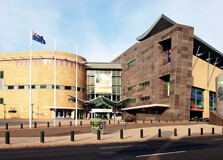
Museum of New Zealand Te Papa Tongarewa
The Museum of New Zealand Te Papa Tongarewa, often simply referred to as Te Papa, is one of the most iconic and influential museums in New Zealand. Located in the capital city of Wellington, it serves as a cultural landmark, showcasing the country's rich history, diverse culture, and fascinating natural environment. This national museum is an essential part of New Zealand's identity, offering visitors an opportunity to explore the unique and diverse heritage of the country. How to Reach Museum of New Zealand Te Papa Tongarewa, Wellington Te Papa is situated in the heart of Wellington, making it easily accessible by various modes of transportation. If you're traveling by car, the museum is located on Cable Street, right by the waterfront. There are several parking facilities near the museum, including both paid and free parking spaces, although these can get busy during peak times. Alternatively, if you're arriving by public transport, Te Papa is well-served by buses, with multiple routes passing through the city center. Wellington's main railway station is also nearby, making it convenient for those traveling by train. Weather in Wellington Wellington is known for its often unpredictable and windy weather. The city experiences a temperate maritime climate, which means mild winters and cool summers. Average temperatures range from 8°C (46°F) in winter to 18°C (64°F) in summer. Rain is frequent throughout the year, so it’s advisable to bring a raincoat or umbrella when visiting Te Papa, especially in the cooler months (June to August). The wind, especially in the spring and winter months, can be strong, so it's a good idea to dress in layers and prepare for sudden weather changes. Timing of Museum of New Zealand Te Papa Tongarewa, Wellington Te Papa is open every day of the week, allowing visitors ample opportunity to explore its many exhibits. The museum’s regular opening hours are from 10:00 AM to 6:00 PM. However, some exhibitions or events may have special timings, so it’s always a good idea to check the museum's official website for any changes before your visit. The museum is free to enter, although some special exhibits and events may require tickets. Why is the Museum of New Zealand Te Papa Tongarewa, Wellington Famous? Te Papa is renowned for being an innovative and interactive museum that offers something for everyone. It is the largest museum in New Zealand and holds collections that span the country’s art, culture, history, and natural sciences. The museum's reputation for being highly engaging and visitor-friendly sets it apart from other museums. Its exhibits are designed to be accessible, informative, and visually stimulating, making it a favorite among tourists and locals alike. One of the most popular exhibits is the colossal squid, which has become a symbol of the museum’s fascinating natural history displays. Entry and Visit Details about Museum of New Zealand Te Papa Tongarewa, Wellington The Museum of New Zealand Te Papa Tongarewa is free to enter, allowing visitors to experience the wonders of New Zealand’s cultural and natural heritage at no cost. While general admission is free, certain exhibitions or special events may have an entry fee. For instance, temporary exhibitions or certain performances may require a paid ticket. It is also advisable to plan your visit in advance, particularly during school holidays and weekends when the museum can get busier. Visitors can also enjoy guided tours for an additional fee, where knowledgeable guides provide detailed insights into the museum’s collections and history. History and Architecture of Museum of New Zealand Te Papa Tongarewa, Wellington The museum’s history dates back to 1865, although it wasn’t until 1998 that the current Te Papa Tongarewa building opened to the public. The name “Te Papa” means "the place of treasures," and it was designed to reflect New Zealand’s diverse cultural and natural heritage. The design of the building is a unique blend of modern architecture and cultural elements, with its striking and innovative structure symbolizing the connection between New Zealand's past and present. The museum’s architecture was a result of a collaboration between New Zealand and international designers, featuring a combination of stone, glass, and steel that allows plenty of natural light to filter through, creating a welcoming environment. The building also boasts vast exhibition spaces, performance areas, and interactive zones that attract visitors of all ages. Things to Do at Museum of New Zealand Te Papa Tongarewa, Wellington When you visit Te Papa, there is no shortage of things to do and see. Some highlights include: Explore the National Art Collection - Te Papa's impressive art collection spans traditional Maori art to contemporary works, showcasing the evolution of New Zealand's artistic identity. Discover Natural History Exhibits - From the famous colossal squid to the reconstructed skeleton of a giant moa, Te Papa’s natural history collection is one of the largest and most fascinating in the country. Engage with Maori Culture - Te Papa offers an in-depth exploration of Maori culture, including their traditions, art, and history, with interactive exhibits and cultural performances. Visit the Gallipoli: The Scale of Our War Exhibit - A poignant and impactful display, this exhibit commemorates New Zealand's involvement in World War I and offers a moving tribute to the soldiers who fought in Gallipoli. Interesting Facts and Tips about Museum of New Zealand Te Papa Tongarewa, Wellington Here are some interesting facts and tips for your visit to Te Papa: Te Papa is not just a museum; it also serves as a hub for events, festivals, and public programs that are held throughout the year. The museum has one of the most significant collections of Maori and Pacific Island artifacts in the world. If you're visiting with children, make sure to check out the interactive exhibits, which are especially designed to engage younger audiences. Don’t miss the opportunity to visit the museum’s rooftop, which offers beautiful views of Wellington’s waterfront and the surrounding area. Be sure to stop by the museum's shop for unique souvenirs, including Maori-inspired art, books, and handmade crafts. Conclusion Te Papa Tongarewa is a must-visit destination for anyone traveling to Wellington. Its exceptional collection, rich history, and interactive displays make it one of New Zealand’s premier cultural institutions. Whether you're interested in art, history, or natural science, Te Papa offers something for everyone, and with free admission, it’s accessible to all. The museum's fascinating exhibits and events ensure that every visit is a memorable and enriching experience. Plan your visit to Te Papa to discover the treasures of New Zealand’s past, present, and future.
Explore More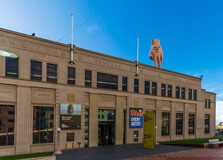
The City Gallery Wellington is one of New Zealand’s most exciting contemporary art spaces, located in the heart of Wellington. This vibrant gallery showcases a diverse range of art forms, from visual arts to thought-provoking exhibitions that explore the intersection of culture, history, and contemporary life. The City Gallery is dedicated to bringing innovative, new, and inspiring art to Wellington’s residents and visitors, providing a platform for both New Zealand and international artists. Whether you're a seasoned art enthusiast or a casual visitor, the City Gallery offers a unique experience that engages the imagination and sparks meaningful conversations. How to Reach City Gallery Wellington, Wellington City Gallery Wellington is located in Civic Square, right in the center of Wellington. The gallery is easily accessible from various parts of the city, whether you are walking, driving, or taking public transport. If you are walking from the city center, the gallery is just a short 5-minute walk from Lambton Quay, Wellington’s main shopping street. For those using public transport, buses and trolley buses frequently stop nearby, making it easy to reach the gallery. The Wellington Railway Station is also just a 15-minute walk from the gallery. If you prefer to drive, there are several parking garages nearby, such as the Wilson Parking building, though finding parking can be challenging during busy times. The gallery’s central location means it is close to many other major attractions, including Te Papa Museum and the Wellington Waterfront. Weather in Wellington Wellington is known for its unpredictable weather, often experiencing rapid changes in temperature and conditions. It has a temperate maritime climate, which means that summers are relatively mild, and winters can be cool and windy. During the summer months (December to February), average temperatures range from 15°C (59°F) to 20°C (68°F). In winter (June to August), temperatures can drop to between 6°C (43°F) and 11°C (52°F). Wellington's weather can be particularly windy, especially in the afternoons, which is why the city is often referred to as the "Windy City." It’s always a good idea to dress in layers and bring a light jacket, even in summer, as the wind can make it feel much cooler than the actual temperature. If you're planning to visit the City Gallery, keep in mind that the gallery's interior is always climate-controlled, ensuring a comfortable visit no matter the weather outside. Timing of City Gallery Wellington, Wellington The City Gallery Wellington is open to the public seven days a week, offering plenty of time for visitors to explore its diverse exhibitions and art collections. The gallery's usual operating hours are from 10:00 AM to 5:00 PM daily, with the exception of Christmas Day and New Year's Day when it is closed. Admission to the gallery is typically free, although special events or major exhibitions may require a ticket. The gallery also hosts late-night openings for certain events, making it possible for visitors to experience the art space after hours. Since the exhibitions change regularly, it’s a good idea to check the gallery’s official website for updates on opening hours, special events, and current exhibitions before your visit. Why is City Gallery Wellington Famous? City Gallery Wellington is famous for its dynamic and ever-changing exhibitions that focus on contemporary art. The gallery has established a reputation as a place where cutting-edge art is displayed, with a strong emphasis on presenting works that reflect contemporary issues, innovative concepts, and global cultural movements. It showcases a wide range of art forms, from painting, sculpture, and photography to video installations and performance art. City Gallery also hosts special exhibitions featuring both well-known and emerging New Zealand artists, as well as international artists whose works address relevant social, political, and cultural topics. The gallery is famous not only for the variety of art it presents but also for its accessibility and commitment to creating an inclusive and engaging environment for all visitors. Entry and Visit Details about City Gallery Wellington City Gallery Wellington is free to enter, providing an affordable opportunity to experience world-class art in the heart of Wellington. The gallery is open every day, except for a few holidays like Christmas Day and New Year's Day. Visitors can simply walk in and enjoy the current exhibitions at no charge. However, for some special events, workshops, or large-scale exhibitions, the gallery may charge a small entry fee, so it’s always best to check their website ahead of time. The gallery is accessible to people of all ages and abilities, with wheelchair access and free Wi-Fi available throughout the space. Audio guides and exhibition catalogues are also available at the gallery, providing additional insights into the art on display. If you’re traveling with young children, there are often family-friendly events and interactive activities designed to make the visit enjoyable for all. History and Architecture of City Gallery Wellington The City Gallery Wellington opened its doors in 1980, originally located in a historic building that was once the Wellington Public Library. The building was designed by the well-known New Zealand architect, William Gray Young, and its classical architecture reflects the grandeur of the late 19th century. The gallery has undergone several renovations over the years to adapt to the growing needs of the art community, but the building’s historical charm has been carefully preserved. In 1990, the gallery moved to its current location in the modern Civic Square, which provided more space for exhibitions and improved accessibility for visitors. The gallery's architecture now features a blend of modern design with traditional elements, creating a welcoming and contemporary space for the presentation of art. The spacious interior is designed to showcase large-scale exhibitions, while the galleries are filled with natural light, creating an inviting environment for art lovers. Things to Do at City Gallery Wellington There is plenty to see and do at City Gallery Wellington, with a wide range of exhibitions and activities for all ages and interests. Some of the highlights include: Explore the Exhibitions – City Gallery Wellington regularly features a variety of exhibitions, showcasing everything from contemporary art to historical art movements. The exhibitions are often thought-provoking, exploring important cultural, social, and political topics. Attend Events and Talks – The gallery often hosts events such as artist talks, panel discussions, and screenings, where visitors can learn more about the works on display and engage with artists, curators, and fellow art lovers. Participate in Workshops – City Gallery offers workshops for both children and adults, allowing visitors to explore their own creativity. These workshops often tie into current exhibitions, offering a hands-on experience that helps visitors connect more deeply with the art. Take a Guided Tour – The gallery offers guided tours for visitors who want to gain a deeper understanding of the artwork on display. Knowledgeable guides provide insights into the artists’ intentions, the significance of the works, and the context in which they were created. Enjoy the City Surroundings – After visiting the gallery, take some time to explore Civic Square, which is home to many other public spaces and landmarks. It’s a perfect spot to relax and enjoy the vibrant atmosphere of Wellington. Interesting Facts and Tips about City Gallery Wellington Here are some interesting facts and tips to help you make the most of your visit to City Gallery Wellington: The gallery is one of the few major public art galleries in New Zealand dedicated solely to contemporary art, making it a must-visit destination for art lovers. Be sure to check out the gallery's calendar of events, as there are often special programs, exhibitions, and live performances that you won’t want to miss. For those interested in local art, City Gallery Wellington regularly features exhibitions from New Zealand’s most prominent and emerging artists. If you’re visiting with children, be on the lookout for family-friendly events and activities designed to make art fun and accessible for younger visitors. Make use of the gallery's educational resources, including catalogues and audio guides, to enhance your experience and learn more about the artworks and their creators. Conclusion City Gallery Wellington is a dynamic and vibrant destination for anyone interested in contemporary art. With its stunning exhibitions, welcoming atmosphere, and commitment to cultural dialogue, the gallery is an essential stop for visitors to Wellington. Whether you’re a passionate art enthusiast or simply curious about the world of contemporary creativity, City Gallery offers a thought-provoking and engaging experience. With its rich history, diverse programming, and central location, the gallery continues to be a vital part of Wellington’s cultural landscape.
Explore More
The Wellington Museum is one of the city's most fascinating attractions, offering a deep dive into the history, culture, and maritime heritage of Wellington and New Zealand. Located on the Wellington waterfront, the museum is housed in a beautifully restored historic building. It provides an engaging and interactive experience, allowing visitors to explore the rich past of the region through well-curated exhibits and immersive displays. Whether you're a local or a tourist, a visit to the Wellington Museum promises to be both educational and enjoyable, showcasing everything from the city’s early settlement history to its modern-day development. How to Reach Wellington Museum, Wellington Wellington Museum is located on the vibrant waterfront area of Wellington, making it easily accessible from various points around the city. The museum is within walking distance from the central business district (CBD) and popular attractions like Te Papa Museum and the Wellington Cable Car. If you're traveling by public transport, the museum is well-served by bus routes, with several stops nearby. The Wellington Railway Station is also just a 10-15 minute walk from the museum, making it easy to access from the train station. For those who prefer to drive, there are several parking options available around the waterfront area, although parking can be limited during peak hours. You may want to consider public transport or walking for a more convenient and stress-free visit. Weather in Wellington Wellington is known for its variable weather, which can change quickly, often in a single day. The city experiences a temperate maritime climate, characterized by cool winters and mild summers. Summer temperatures (December to February) generally range from 18°C (64°F) to 20°C (68°F), while in winter (June to August), temperatures can drop to 6°C (43°F) to 11°C (52°F). One of Wellington’s most famous characteristics is its wind, which can be particularly strong in the afternoons, especially near the waterfront. Due to the unpredictable nature of the weather, it’s a good idea to dress in layers and carry an umbrella or jacket when visiting the Wellington Museum. Regardless of the weather, the museum’s interior is comfortable and climate-controlled, offering a pleasant experience inside. Timing of Wellington Museum, Wellington The Wellington Museum is open every day of the week, making it convenient for visitors to explore its exhibits. The usual opening hours are from 10:00 AM to 5:00 PM, with extended hours during special events or peak tourist seasons. The museum is closed on Christmas Day and New Year's Day, so be sure to check its website for any holiday closures before planning your visit. Admission to the museum is free, though some special events or exhibitions may have an entry fee. It’s a good idea to check the official website for any updates or changes to the timings or special exhibitions before you go. The museum also organizes various events and activities throughout the year, such as guided tours and workshops, which may have specific timings, so keep an eye out for these exciting opportunities. Why is Wellington Museum Famous? The Wellington Museum is famous for offering a captivating glimpse into the rich and diverse history of Wellington and New Zealand. The museum’s exhibits are centered around the city’s maritime history, colonial past, and the transformation into the vibrant, modern city that it is today. The museum is housed in a historic building, which was originally constructed in 1892 as a bonded warehouse for shipping goods, providing visitors with a sense of historical authenticity. Inside, the museum boasts interactive displays and immersive exhibits, making it a favorite spot for both families and history enthusiasts. One of the most popular exhibits is the “Wellington’s Early Days” section, where visitors can learn about the founding of the city, the growth of the port, and the impact of immigration and industry. The museum also offers fascinating displays about Wellington’s natural environment, Māori culture, and the city’s role in New Zealand’s wider history. Entry and Visit Details about Wellington Museum Wellington Museum offers free entry, making it an affordable cultural experience for everyone. Visitors are welcome to explore the museum at their own pace, and the interactive displays and informative exhibitions make it suitable for all ages. The museum provides a range of family-friendly activities and exhibitions, ensuring that younger visitors are also engaged throughout their visit. Although admission is free, donations are encouraged to help support the museum’s educational programs and ongoing preservation of exhibits. The museum is wheelchair accessible, with ramps and elevators to make it easy for all visitors to explore its galleries. Audio guides and informational leaflets are available to enhance the visitor experience, offering additional details about the exhibits. Guided tours are also available for those who wish to learn more about the museum’s history and exhibits from a knowledgeable guide. History and Architecture of Wellington Museum The Wellington Museum is housed in a historical building that dates back to 1892. Originally known as the Old Bond Store, the building was designed by the architectural firm Gray Young, and it was used as a bonded warehouse for storing goods imported into Wellington. The building's historical significance lies in its role as part of the city’s early economic development, particularly related to the port and shipping industry. The structure features beautiful Victorian-era design elements, with large windows, exposed brickwork, and decorative timber finishes. The building was carefully restored in the early 2000s to accommodate the museum’s modern exhibits while preserving the original architecture. The combination of historical charm and contemporary design creates a unique and inviting atmosphere for museum-goers. The layout of the museum reflects the building’s history, with spacious galleries spread across multiple levels, providing an interesting contrast between the old and the new. Things to Do at Wellington Museum There are plenty of things to see and do at Wellington Museum, making it a great destination for visitors of all ages. Some of the highlights include: Explore the Exhibitions – The museum’s permanent collections offer a fascinating look at Wellington’s history, including displays about the city’s early settlement, its maritime heritage, and its development into a cultural hub. Be sure to check out the interactive exhibits that engage visitors with the stories of the city’s past. Visit the ‘Wellington’s Early Days’ Exhibit – This exhibit explores the history of Wellington from its founding through to the 19th century. It highlights the city’s role as a key port and the influence of European settlers and Māori communities on its development. Learn About Wellington’s Maritime Heritage – One of the museum's key themes is the role of the port in the city's growth. The maritime exhibits offer insights into Wellington's trade, shipping, and exploration history. Take a Guided Tour – Join one of the museum’s guided tours for an in-depth look at the exhibits and stories behind them. The knowledgeable guides provide engaging and informative commentary, making the visit even more enriching. Participate in Family-Friendly Activities – The museum regularly hosts hands-on workshops and family-friendly events, such as craft activities or storytelling sessions, making it a great place for children to learn about Wellington’s history in an interactive and fun way. Interesting Facts and Tips about Wellington Museum Here are some interesting facts and helpful tips for your visit to the Wellington Museum: The museum’s building, the Old Bond Store, was originally designed to store imported goods for Wellington’s bustling port in the late 19th century. Admission to the museum is free, making it an affordable option for families, students, and tourists on a budget. Donations are encouraged to help the museum continue its educational programs and preserve its historical collections. Be sure to check the museum’s website or social media pages for information on temporary exhibitions, special events, and educational programs. Allow around 1-2 hours to fully explore the museum, though you may wish to spend more time if you're particularly interested in the history of Wellington. Since the museum is located on the waterfront, it's a great idea to pair your visit with a walk along the scenic Wellington waterfront or enjoy a meal at one of the nearby cafes. Conclusion Wellington Museum is a must-visit attraction for anyone interested in learning about the rich history and culture of Wellington and New Zealand. The museum’s fascinating exhibits, engaging storytelling, and immersive displays provide a deep understanding of the city’s maritime past, colonial history, and growth as a modern urban center. Whether you're a history buff or just looking for an educational and enjoyable experience, the Wellington Museum offers something for everyone. With free admission, it’s an accessible and enriching destination for tourists and locals alike. Make sure to visit this cultural gem when you’re in Wellington, and take the time to discover the stories that shaped the city.
Explore More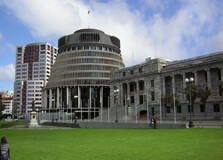
The Beehive is one of New Zealand’s most iconic and recognizable buildings, located in the heart of Wellington, the country’s capital. Officially known as the Executive Wing of the New Zealand Parliament Buildings, The Beehive serves as the workplace of the Prime Minister and other members of the Cabinet. Its unique architectural design and prominent position in Wellington make it a must-see for anyone visiting the city. The building is not only a political center but also a key symbol of New Zealand's democratic government. The Beehive is a testament to the country’s commitment to innovation, modernity, and its strong political heritage. How to Reach The Beehive, Wellington Located in the central business district of Wellington, The Beehive is easily accessible from various parts of the city. If you're staying within Wellington's CBD, it is just a short walk away from many popular landmarks such as the Wellington Waterfront and Te Papa Museum. The building is situated on the Parliamentary Precinct, which is near other government buildings, including the New Zealand Parliament House. For those using public transport, the Wellington Railway Station is approximately a 15-minute walk away, and multiple bus routes pass through nearby streets, making it simple to reach the Beehive from other parts of the city. There is also a bus stop right outside the Parliament Buildings, further enhancing accessibility. If you are driving, there is limited parking around the area, but it’s advised to use public transport or walk due to traffic congestion and parking restrictions. Weather in Wellington Wellington is known for its changeable weather, often referred to as a “four seasons in one day” climate. This is due to the city’s location between the Cook Strait and the Tararua Range, which makes it prone to sudden changes in weather patterns. Summer (December to February) in Wellington is mild, with temperatures averaging between 18°C (64°F) and 22°C (72°F). Winter (June to August) can be cool and windy, with temperatures ranging from 7°C (45°F) to 12°C (54°F). The city is particularly famous for its strong winds, especially around the waterfront, so visitors should be prepared for gusty conditions. It’s always a good idea to bring a jacket or sweater, even in summer, and to layer your clothing as temperatures can fluctuate throughout the day. Timing of The Beehive, Wellington The Beehive is primarily a government building, so while visitors can admire its architecture and take photos from the outside, access to the interior is more limited. However, guided tours of the New Zealand Parliament Buildings, including The Beehive, are available. These tours are typically scheduled on weekdays and can be booked in advance. The tours provide an in-depth look at the history, architecture, and functioning of New Zealand’s government. The Beehive itself is not open to the general public without a tour, as it is an active working government office. For general public access to Parliament and the surrounding grounds, the usual hours are from 9:00 AM to 5:00 PM. Visitors should check the New Zealand Parliament website for tour schedules and booking information, as times may vary depending on parliamentary schedules and other events. Why is The Beehive Famous? The Beehive is famous for its distinctive, futuristic design and its role as the seat of executive government in New Zealand. The building is one of Wellington's most photographed landmarks due to its unique and unconventional shape, which resembles a beehive, hence its name. Designed by architect Sir Basil Spence, The Beehive was completed in 1977 and became an instant architectural icon. Its bold, modern design contrasts with the more traditional Parliament House and is a symbol of New Zealand’s forward-thinking approach to governance. The Beehive’s central location within the Parliamentary Precinct further enhances its significance as a political and cultural symbol for the country. Entry and Visit Details about The Beehive, Wellington Visitors to Wellington can freely admire The Beehive from the outside, as it is located within the Parliamentary Grounds, which are open to the public. However, if you are interested in exploring the interior of The Beehive and learning more about New Zealand’s government and political system, you can take part in one of the guided tours offered by the New Zealand Parliament. These tours provide an informative and engaging experience, offering insights into the architecture, history, and role of Parliament in New Zealand’s democratic process. The tours are free of charge, but it is advisable to book them in advance, as they can get busy, particularly during tourist seasons. The tours typically last around 45 minutes and allow visitors to learn about the building’s design, explore the history of New Zealand’s Parliament, and view key spaces such as the Cabinet Room and the Parliamentary Library. Visitors must go through a security check to enter the building, so it’s important to bring a valid form of identification. The tours are suitable for all ages and offer an educational experience for those interested in New Zealand’s political system and history. History and Architecture of The Beehive The Beehive was designed by Sir Basil Spence, a renowned British architect, and was completed in 1977. The building’s unique design was chosen to complement the existing Parliament House and the surrounding Parliamentary Buildings, while also representing a modern approach to government. The Beehive’s circular structure and distinctive, stepped design symbolize the executive branch of New Zealand’s government, with each level representing a different aspect of governance. The building's iconic shape makes it one of the most recognizable pieces of modern architecture in New Zealand. Standing 72 meters tall with 10 stories, the Beehive is composed of reinforced concrete and features a distinctive concrete exterior with a series of sloping, tiered levels. The open space in the middle of the building allows natural light to penetrate the interior, creating a bright and airy atmosphere. The building’s design also incorporates sustainable features, including energy-efficient lighting and heating systems. Interestingly, while The Beehive is one of the most photographed buildings in Wellington, it was not immediately popular with all of New Zealand’s citizens upon its completion. Over time, however, the building has come to be seen as an iconic and beloved part of the nation’s political landscape. Today, it remains a key symbol of New Zealand’s political history and modern governance. Things to Do at The Beehive, Wellington While the main attraction of The Beehive is its unique design and its significance as the seat of the executive government, there are several things to do in the surrounding area that make a visit even more worthwhile: Take a Guided Tour – Explore the interior of the building and learn about the history, architecture, and government operations of New Zealand. Guided tours provide a unique and educational experience that gives a deeper understanding of the country's political system. Visit the New Zealand Parliament Buildings – While at The Beehive, take time to explore the entire Parliamentary Precinct, which includes the historic Parliament House, the Parliamentary Library, and the beautifully landscaped grounds. Stroll Through the Grounds – The Parliamentary Grounds surrounding The Beehive are open to the public, offering beautifully landscaped gardens, statues, and historical monuments. It’s a peaceful spot to relax and take in the views of the city. Learn about New Zealand’s Political System – Take the opportunity to learn more about how New Zealand’s government works, the role of Parliament, and the political history of the country. There are informative displays in the nearby Parliamentary Buildings that offer fascinating insights into New Zealand’s democratic system. Interesting Facts and Tips about The Beehive Here are some interesting facts and helpful tips for visiting The Beehive: The Beehive is not just an iconic building; it is a functional workplace for the Prime Minister and other members of the Cabinet, making it a key center of decision-making in New Zealand. The building is named “The Beehive” due to its distinct, beehive-like shape, which stands out from the more traditional Parliament House next door. While the building itself is an impressive sight, don't forget to explore the surrounding area, which includes several other important government buildings and the scenic Parliamentary Grounds. If you plan on taking a guided tour, make sure to book your spot in advance, especially during the peak tourist season, as tours can fill up quickly. Bring a camera to capture the unique shape of The Beehive from different angles – it’s one of Wellington’s most photogenic landmarks. Conclusion The Beehive is a must-see landmark in Wellington, offering visitors a glimpse into the heart of New Zealand’s political system while showcasing one of the country’s most iconic pieces of modern architecture. Whether you’re interested in politics, architecture, or simply exploring Wellington’s cultural landmarks, The Beehive provides a fascinating experience. Make sure to take a guided tour to learn more about its design, history, and significance, and enjoy the surrounding Parliamentary Grounds for a complete experience. The Beehive remains a proud symbol of New Zealand’s democratic values and a testament to the country's forward-thinking approach to governance.
Explore More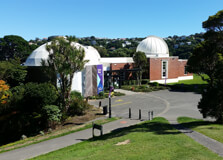
Space Place at Carter Observatory
Located in Wellington, New Zealand, Space Place at Carter Observatory is a must-visit destination for astronomy enthusiasts and anyone curious about the mysteries of the universe. With interactive exhibits, a high-tech planetarium, and fascinating insights into New Zealand's role in space exploration, Space Place offers an educational and entertaining experience for visitors of all ages. How to Reach Space Place at Carter Observatory, Wellington Space Place is situated at 40 Salamanca Road, Kelburn, Wellington. It is easily accessible by various means of transportation: By Cable Car: The Wellington Cable Car is a popular and scenic way to reach Space Place. Take the cable car from Lambton Quay and get off at the Kelburn terminal. A short walk through the Botanic Garden will lead you to Space Place. By Car: If you’re driving, there is limited parking available near the observatory. The nearest parking areas include Salamanca Road and the nearby streets. By Public Transport: Several buses connect the central city with the Kelburn area. The observatory is a short walk from the closest bus stops. Weather and Best Time to Visit Wellington has a temperate maritime climate with mild summers and cool winters. The best time to visit Space Place is on clear nights when the observatory’s telescopes can be used for stargazing. Summer months (December to February) offer pleasant weather, but winter nights (June to August) can also provide crisp, clear skies ideal for astronomy. Timing of Space Place at Carter Observatory Space Place operates on a schedule that varies depending on the season. It is generally open: Tuesday to Sunday: 10:00 AM – 5:30 PM Late Night Sessions: Some evenings offer extended hours for night sky viewing (check the official website for details). Closed: Mondays (except public holidays) Why is Space Place at Carter Observatory Famous? Space Place is renowned for its impressive planetarium shows, interactive science exhibits, and historical significance in New Zealand’s astronomical research. It serves as a gateway to understanding the southern hemisphere’s night sky and the indigenous Māori perspectives on celestial navigation. The observatory has been a center for astronomical study for decades, making it a key attraction in Wellington. Entry and Visit Details The entry fees and visit details are as follows: Adults: Around NZD 14 – 18 Children (4-16 years): Around NZD 9 – 10 Family Pass: Available for discounted rates Concession Rates: Students and seniors may receive discounts It is recommended to book tickets in advance, especially for planetarium shows and guided telescope viewing sessions. History and Architecture Established in 1941, Carter Observatory was named after Charles Rooking Carter, a philanthropist who funded its creation. Over the years, it has been transformed into a modern space education center while retaining its historic charm. The observatory’s architecture blends classic scientific design with contemporary exhibition spaces, making it both a cultural and scientific landmark. Things to Do at Space Place Planetarium Shows: Experience immersive full-dome movies about space, black holes, and celestial wonders. Telescope Viewing: On selected nights, visitors can observe planets and stars through powerful telescopes. Interactive Exhibits: Learn about the solar system, space exploration, and New Zealand’s contributions to astronomy. Walkthrough the Botanic Gardens: Since Space Place is located within Wellington Botanic Garden, visitors can enjoy scenic walks before or after their visit. Interesting Facts Space Place has one of the most advanced digital planetariums in New Zealand. It features a special exhibit on Māori astronomy and traditional celestial navigation. The observatory is over 80 years old and has played a significant role in New Zealand’s space education. The telescope used at Space Place is a Thomas Cooke & Sons 9 ¾-inch refractor, dating back to the 19th century. Tips for Visiting Book planetarium tickets in advance to secure a good seat. Visit on a clear night for the best telescope viewing experience. Wear comfortable clothing, especially during winter when outdoor viewing can be chilly. Allow extra time to explore nearby attractions, such as the Cable Car Museum and the Botanic Gardens.
Explore More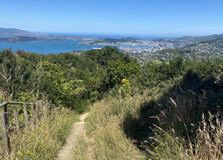
Mount Kaukau is one of the most prominent landmarks in Wellington, New Zealand. Standing at 445 meters above sea level, it offers breathtaking panoramic views of the city, harbor, and surrounding hills. The peak is a popular destination for hikers, nature enthusiasts, and anyone looking to enjoy the beauty of Wellington’s natural landscape. How to Reach Mount Kaukau There are several ways to access Mount Kaukau: By Car: Drive to Khandallah or Johnsonville, where various trailheads lead to the summit. By Public Transport: Buses from Wellington’s city center stop near the trail entrances in Khandallah and Johnsonville. By Foot: The most popular access point is from the Simla Crescent entrance in Khandallah. Weather and Best Time to Visit Wellington’s weather can be unpredictable, with strong winds being a common occurrence. The best time to hike Mount Kaukau is during summer (December to February) when temperatures are mild and skies are clearer. Spring and autumn are also good, but visitors should be prepared for changing conditions. Why is Mount Kaukau Famous? Mount Kaukau is known for its stunning views, rich biodiversity, and its role as a key location for Wellington’s television transmission tower. The mountain’s trails offer a mix of bushwalks and open ridges, making it a favorite among hikers and fitness enthusiasts. Things to Do at Mount Kaukau Hiking: Several trails lead to the summit, with varying levels of difficulty. Scenic Views: Enjoy panoramic vistas of Wellington, the South Island, and the Tararua Range. Wildlife Spotting: Look out for native birds like tui and kererū. Photography: Capture the stunning landscapes and city views. Interesting Facts Mount Kaukau is the highest point in Wellington’s northern skyline. The television transmission tower at the summit is one of Wellington’s tallest structures. The trails offer connections to the Northern Walkway, a major hiking route in the city. Tips for Visiting Wear comfortable hiking shoes and bring water. Check the weather forecast before heading up. Start early in the day to enjoy the best lighting for photography. Respect the natural environment and stay on designated trails.
Explore MoreNew Zealand North - South Island 9 Days 8 Nights Tour
9 Days/ 8 Night
Auckland - Christchurch - Rotorua - Queenstown
7D - 6N New Zealand Tour Package
7 Days/ 6 Night
West Coast - Milford Sound - Christchurch - Queenstown - Greymouth
New Zealand - Mountain Magnificence - Adrenaline - Queenstown In 5 Days Tour
5 Days/ 4 Night
Queenstown
New Zealand Adrenaline Rush 10N - 11D Tour
11 Days/ 10 Night
Auckland - Christchurch - Rotorua - Queenstown
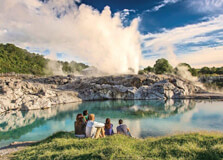
Te Puia is one of the most popular cultural and geothermal attractions in Rotorua, New Zealand. It is home to the famous Pohutu Geyser, bubbling mud pools, and the New Zealand Māori Arts and Crafts Institute. Visitors can explore the rich Māori heritage, witness geothermal wonders, and experience traditional cultural performances, making Te Puia a must-visit destination. How to Reach Te Puia, Rotorua Te Puia is conveniently located in Rotorua and is easily accessible by various means: By Car: Te Puia is about 5 minutes from Rotorua city center. There is ample parking available on-site. By Bus: Several tour buses and public transport options connect Rotorua’s main areas to Te Puia. By Air: Rotorua has a domestic airport with flights from major cities like Auckland and Wellington. Weather and Best Time to Visit Rotorua has a mild climate throughout the year. The best time to visit Te Puia is during the spring and summer months (September to March) when temperatures are warm and the geothermal attractions can be comfortably explored. However, the geothermal activity is visible year-round, making any time a good time to visit. Timing of Te Puia Te Puia is open daily with the following schedule: Opening Hours: 8:30 AM – 5:00 PM Evening Cultural Performances: Available on select nights with dinner packages Visitors are encouraged to check the official website for any changes in timings or special events. Why is Te Puia Famous? Te Puia is famous for its geothermal features, particularly the Pohutu Geyser, which is the largest active geyser in the Southern Hemisphere. It is also renowned for preserving and showcasing Māori culture through traditional carvings, weaving, and performances. The combination of natural wonders and cultural experiences makes it a unique attraction in New Zealand. Entry and Visit Details The entry fees for Te Puia vary depending on the type of experience chosen: General Admission: NZD 50 – 60 for adults Children (5-15 years): NZD 25 – 30 Family Pass: Discounted rates available Guided Tours and Cultural Performances: Available at additional cost It is recommended to book tickets online in advance, especially for cultural performances and guided tours. History and Architecture Te Puia has a rich history deeply connected to the indigenous Māori people. The New Zealand Māori Arts and Crafts Institute, established in 1963, ensures the preservation of traditional Māori skills such as carving and weaving. The architecture of Te Puia incorporates traditional Māori designs, using intricate carvings that tell ancestral stories. Things to Do at Te Puia Visit the Pohutu Geyser: Witness the spectacular eruptions of this famous geyser. Explore the Geothermal Valley: Discover boiling mud pools, steaming vents, and hot springs. Experience Māori Culture: Enjoy traditional performances, storytelling, and cultural workshops. Visit the Kiwi Conservation Center: See New Zealand’s iconic kiwi bird in a specially designed habitat. Enjoy Māori Cuisine: Try authentic hāngī (earth-cooked meal) at Te Puia’s restaurant. Interesting Facts About Te Puia The Pohutu Geyser can erupt up to 30 meters high and erupts several times a day. Te Puia spans over 60 hectares of geothermal valley and cultural heritage land. The Māori Arts and Crafts Institute has trained generations of artists in traditional carving and weaving techniques. The site is managed by the local iwi (tribe), ensuring authentic Māori representation and preservation. Tips for Visiting Wear comfortable walking shoes as the geothermal area has uneven terrain. Bring a camera to capture the stunning geothermal landscapes and cultural performances. Book a guided tour to learn in-depth details about Māori history and the geothermal wonders. Visit early in the day to avoid crowds and enjoy a more immersive experience.
Explore More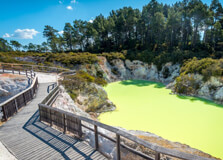
Waiotapu Thermal Wonderland is one of New Zealand’s most spectacular geothermal attractions. Located near Rotorua, this unique landscape features vibrant geothermal pools, steaming vents, bubbling mud pools, and erupting geysers. It is a must-visit destination for nature lovers and those interested in volcanic activity. How to Reach Waiotapu Thermal Wonderland, Rotorua Waiotapu Thermal Wonderland is located about 27 kilometers south of Rotorua and can be accessed in several ways: By Car: The site is about a 30-minute drive from Rotorua via State Highway 5. Free parking is available on-site. By Tour Bus: Many guided tours include Waiotapu in their itineraries from Rotorua or Taupō. By Public Transport: There are limited public transport options, so it is recommended to drive or join a tour. Weather and Best Time to Visit Rotorua experiences a temperate climate with mild summers and cool winters. Waiotapu Thermal Wonderland can be visited year-round, but the best time to explore is during the spring and summer months (September to March) when the weather is warmer and the colors of the geothermal pools appear more vibrant. Timing of Waiotapu Thermal Wonderland Waiotapu Thermal Wonderland operates on the following schedule: Opening Hours: 8:30 AM – 5:00 PM (last admission at 3:45 PM) Lady Knox Geyser Eruption: Daily at 10:15 AM Closed: On Christmas Day It is advisable to arrive early to experience the Lady Knox Geyser eruption and avoid crowds. Why is Waiotapu Thermal Wonderland Famous? Waiotapu is renowned for its stunning geothermal features, including the iconic Champagne Pool, bubbling mud pools, and vibrant mineral deposits. It is considered one of the most colorful geothermal areas in the world, attracting thousands of visitors each year. The site is also known for the daily eruption of the Lady Knox Geyser. Entry and Visit Details The entry fees for Waiotapu Thermal Wonderland are as follows: Adults: NZD 32.50 Children (5-15 years): NZD 11.00 Family Pass: NZD 80.00 (2 adults + 3 children) Guided Tours: Available at additional cost Tickets can be purchased online or at the entrance. Guided tours provide in-depth information about the geothermal features. History and Geothermal Formation The geothermal activity at Waiotapu has been forming for thousands of years due to the volcanic activity beneath the Earth’s surface. The name “Waiotapu” means “Sacred Waters” in Māori, reflecting its cultural and geological significance. The area has been shaped by intense geothermal activity, creating unique formations like sinter terraces, hot springs, and mineral-rich pools. Things to Do at Waiotapu Thermal Wonderland Visit the Champagne Pool: One of the most famous geothermal pools with striking orange and blue hues. Watch the Lady Knox Geyser: Witness the daily eruption of this geyser, reaching up to 20 meters in height. Explore the Bubbling Mud Pools: See natural mud pools in constant motion due to geothermal activity. Walk the Geothermal Trails: Choose from different walking tracks to explore the various geothermal wonders. Photography: Capture the otherworldly landscapes created by mineral deposits and geothermal activity. Interesting Facts About Waiotapu Thermal Wonderland The Champagne Pool gets its name from the constant release of carbon dioxide bubbles, resembling a glass of champagne. The vibrant colors in the pools come from different minerals like sulfur, arsenic, and manganese. The Lady Knox Geyser is named after Lady Constance Knox, the daughter of a former New Zealand governor. Waiotapu covers an area of 18 square kilometers, making it one of the largest geothermal areas in New Zealand. Tips for Visiting Waiotapu Thermal Wonderland Wear comfortable walking shoes as the geothermal area has uneven terrain. Bring a hat, sunscreen, and water if visiting during summer. Arrive early to see the Lady Knox Geyser eruption. Stick to the marked trails to ensure safety around geothermal pools. Carry a camera to capture the stunning natural formations and colors.
Explore More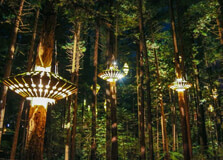
The Redwood Treewalk in Rotorua is one of New Zealand’s most unique eco-tourism experiences. Suspended high among the towering Californian Redwoods, this walk offers breathtaking views of the forest, a peaceful atmosphere, and an opportunity to experience nature in a spectacular way. How to Reach Redwood Treewalk, Rotorua The Redwood Treewalk is located in the Whakarewarewa Forest, just a short distance from Rotorua’s city center. By Car: It takes about 5-10 minutes to drive from Rotorua’s city center. Parking is available near the entrance. By Bike: Rotorua is a bike-friendly city, and cycling to the forest is a great way to explore the area. By Public Transport: Some local bus services operate routes close to the Whakarewarewa Forest. Weather and Best Time to Visit Rotorua experiences a temperate climate with mild temperatures year-round. The best time to visit the Redwood Treewalk is: Spring and Summer (September to March): Pleasant temperatures and vibrant greenery make this a great time to visit. Autumn (April to May): The changing colors of the leaves add to the scenic beauty. Winter (June to August): A unique experience with misty and atmospheric surroundings. Timing of Redwood Treewalk The Redwood Treewalk operates during the following hours: Day Walk: 9:00 AM – 10:30 PM (last entry at 10:00 PM) Night Walk: Begins at dusk and lasts until 10:30 PM Open 7 Days a Week, including public holidays Why is Redwood Treewalk Famous? The Redwood Treewalk is famous for its suspension bridges and platforms that provide a serene and immersive way to experience the beauty of the towering redwoods. It is also known for the enchanting Nightlights Treewalk, featuring glowing lanterns designed by renowned designer David Trubridge. Entry and Visit Details The entry fees for the Redwood Treewalk are: Adults: NZD 39.00 Children (5-15 years): NZD 19.00 Family Pass: NZD 99.00 (2 adults + 2 children) Nightlights Experience: Additional fees apply It is recommended to book tickets online, especially for the Nightlights experience, as it is a popular attraction. History and Architecture The Redwood forest in Rotorua was planted in 1901 as an experimental timber plantation. Over the years, it has become a beloved natural area for locals and tourists alike. The Treewalk was constructed with eco-friendly materials, ensuring minimal impact on the trees while offering a safe and enjoyable experience. Things to Do at Redwood Treewalk Daytime Treewalk: Experience the beauty of the towering trees from 20 meters above the ground. Nightlights Experience: Walk among lantern-lit bridges for a magical and immersive adventure. Explore the Forest Trails: Enjoy various walking and biking tracks around the forest. Photography: Capture breathtaking views of the forest from different heights. Interesting Facts About Redwood Treewalk The walkway consists of 28 suspension bridges and platforms. The tallest redwoods in the forest stand at over 70 meters. The Nightlights Treewalk features over 30 custom-designed lanterns. It is one of the longest tree-based walkways in the world. Tips for Visiting Redwood Treewalk Wear comfortable shoes as the walkway requires some walking. Visit in the evening for the Nightlights experience. Bring a camera to capture the stunning views. Book tickets in advance to secure your preferred time slot.
Explore More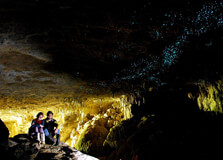
The Waitomo Glowworm Caves are one of New Zealand’s most extraordinary natural attractions, famous for their stunning glowworm displays. These caves are home to thousands of Arachnocampa luminosa, a species of glowworm unique to New Zealand, which illuminate the caves with their bioluminescent glow, creating a magical underground experience. How to Reach Waitomo Glowworm Caves, Rotorua Waitomo Glowworm Caves are located in the Waitomo region, approximately 2.5 hours’ drive from Rotorua. Here are the best ways to get there: By Car: The most convenient way to reach the caves is by car. Follow State Highway 5 towards Tirau, then take State Highway 1 and State Highway 3 to reach Waitomo. By Tour Bus: Several tour companies operate day trips from Rotorua to Waitomo. By Public Transport: Limited bus services are available between Rotorua and Waitomo, so check schedules in advance. Weather and Best Time to Visit Waitomo has a temperate climate, making it a great year-round destination. The caves maintain a cool and consistent temperature of around 12-14°C (54-57°F), regardless of the season. Spring and Summer (September to March): Pleasant weather for exploring the surrounding countryside. Autumn and Winter (April to August): Fewer crowds and a more intimate cave experience. Timing of Waitomo Glowworm Caves The caves are open daily with the following hours: Monday to Sunday: 9:00 AM – 5:00 PM Last Tour: Usually departs at 4:30 PM Special night tours may be available upon request. Why are Waitomo Glowworm Caves Famous? Waitomo Glowworm Caves are famous for their mesmerizing glowworm-lit ceilings, which resemble a starry night sky. The caves also feature stunning limestone formations, underground rivers, and impressive stalactites and stalagmites formed over millions of years. Entry and Visit Details Visitors can explore the caves through guided tours. Ticket prices are: Adults: NZD 55.00 Children (4-14 years): NZD 25.00 Family Pass: NZD 150.00 (2 adults + 2 children) Combination Tours: Options include visits to other nearby caves, such as Ruakuri Cave and Aranui Cave. History and Architecture The caves were first explored by local Māori in the 1800s and later became a major tourist attraction. The stunning rock formations inside the caves have taken thousands of years to develop. The glowworms create their light to attract insects, using bioluminescence in a spectacular natural display. Things to Do at Waitomo Glowworm Caves Glowworm Boat Tour: Drift silently through the caves on a guided boat tour while marveling at the glowworm-lit ceiling. Adventure Caving: For thrill-seekers, activities such as black water rafting, abseiling, and cave tubing are available in nearby caves. Photography: Although photography is not allowed inside the glowworm caves, you can capture stunning shots of the surrounding limestone formations. Walks and Trails: Explore the scenic Waitomo Walkway and discover breathtaking natural landscapes. Interesting Facts About Waitomo Glowworm Caves The caves are over 30 million years old. The glowworms emit light through a chemical reaction in their tails. Over half a million visitors explore the caves each year. The name “Waitomo” means “water passing through a hole” in Māori. Tips for Visiting Waitomo Glowworm Caves Book tickets in advance, especially during peak seasons. Wear comfortable walking shoes, as the caves can be damp. Dress warmly, as the cave temperature is cool year-round. Consider combining your visit with other nearby attractions.
Explore More
Hell's Gate is one of Rotorua’s most famous geothermal attractions, known for its steaming vents, boiling mud pools, and therapeutic sulfur baths. It is one of the most active geothermal fields in New Zealand and has been used by the Māori people for centuries for healing and relaxation. How to Reach Hell's Gate, Rotorua Hell's Gate is located about 15 minutes from Rotorua’s city center and can be reached by: By Car: Drive east along State Highway 30. Free parking is available on-site. By Shuttle: Hell’s Gate offers a shuttle service from Rotorua, which can be booked in advance. By Public Transport: Local buses operate in Rotorua, but a car or shuttle is the most convenient option. Weather and Best Time to Visit Rotorua has a temperate climate, making Hell’s Gate a great destination year-round. However: Summer (December to February): Warm temperatures make the experience pleasant. Winter (June to August): The hot pools are especially soothing in cooler weather. Timing of Hell's Gate Hell’s Gate is open daily from 10:00 AM to 6:00 PM, with the last entry at 5:00 PM. Why is Hell's Gate Famous? Hell's Gate is famous for its intense geothermal activity, therapeutic mud baths, and sulfur-rich pools. It is the only geothermal park in New Zealand where visitors can bathe in mineral mud, which is believed to have healing properties. Entry and Visit Details Hell’s Gate offers different experiences, including geothermal walks, mud baths, and spa treatments. Prices vary depending on the activities chosen. History and Architecture The area has been used by the Māori for over 700 years for healing and relaxation. The name "Hell's Gate" was given by Irish playwright George Bernard Shaw in the 1900s due to the area's dramatic geothermal features. Things to Do at Hell's Gate Geothermal Walk: Explore boiling mud pools, hot water falls, and steaming fumaroles. Mud Bath Experience: Enjoy a therapeutic mud bath that softens and detoxifies the skin. Sulfur Spa: Relax in mineral-rich hot pools with healing properties. Traditional Māori Carving: Learn about Māori wood carving and create your own souvenir. Interesting Facts About Hell's Gate It contains the Southern Hemisphere’s largest hot-water waterfall. The mud from Hell's Gate is exported worldwide for beauty treatments. Māori warriors traditionally used the hot springs to heal battle wounds. Tips for Visiting Hell's Gate Wear old swimwear for the mud baths, as the sulfur smell can linger. Rinse off thoroughly after using the sulfur pools. Book in advance for the spa and mud bath experiences. Follow safety signs around geothermal areas.
Explore More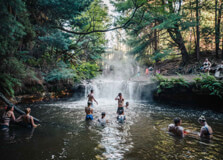
Kerosene Creek is a natural hot spring located near Rotorua, New Zealand. It is a popular geothermal attraction where a warm stream flows through a scenic forest, creating natural hot pools for visitors to enjoy. The creek is completely free to access and offers a unique and relaxing experience in nature. How to Reach Kerosene Creek, Rotorua Kerosene Creek is located about 30 minutes south of Rotorua, off State Highway 5. Visitors can reach the creek by: By Car: Drive along SH5 towards Taupo, turn onto Old Waiotapu Road, and follow the gravel road to the parking area. By Public Transport: There are no direct public transport options, so renting a car or joining a tour is recommended. By Tour: Some local tour companies include Kerosene Creek as part of their geothermal experience packages. Weather and Best Time to Visit Rotorua has a mild climate, making Kerosene Creek a great place to visit throughout the year. However, the best times to visit are: Summer (December to February): The warm weather makes it a great time to enjoy a relaxing soak. Winter (June to August): The contrast of the cool air and warm water creates a soothing experience. Timing of Kerosene Creek Kerosene Creek is open to visitors 24/7, and there is no official entry fee. Why is Kerosene Creek Famous? Kerosene Creek is famous for its natural geothermal waters, which create a warm, relaxing environment amidst a lush forest. It is one of the few places in New Zealand where visitors can bathe in a free, naturally heated stream. Entry and Visit Details There is no charge to visit Kerosene Creek, making it a popular spot for both locals and tourists. However, the area is unmonitored, so visitors should take precautions when visiting. History and Natural Formation Kerosene Creek is a naturally occurring hot spring, heated by geothermal activity beneath the Earth's surface. The stream flows over a small waterfall into a series of pools, allowing visitors to soak in naturally warm waters. Things to Do at Kerosene Creek Soaking in the Hot Pools: Relax in the warm, mineral-rich water. Exploring the Forest: Enjoy a short walk around the surrounding native bushland. Photography: Capture the beauty of the natural hot spring and its serene surroundings. Picnic: Bring some food and have a picnic in the nearby areas. Interesting Facts About Kerosene Creek Kerosene Creek gets its name from the occasional sulfuric smell in the water, similar to kerosene. It is one of the few free hot springs in the Rotorua region. The water temperature varies but generally stays warm due to geothermal heating. It is surrounded by native New Zealand bush, providing a peaceful and natural setting. Tips for Visiting Kerosene Creek Visit early in the morning or late in the afternoon to avoid crowds. Be mindful of personal belongings, as the area is unattended. Wear water shoes as the stream bed can be slippery. Rinse off after your visit to remove any sulfur residue from your skin. Respect the natural environment and take all trash with you.
Explore More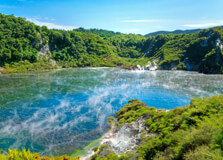
Waimangu Volcanic Valley is a unique geothermal attraction in Rotorua, New Zealand. It is the world's youngest geothermal system, created by the eruption of Mount Tarawera in 1886. The valley features stunning hot springs, steaming lakes, bubbling mud pools, and a diverse range of flora and fauna. How to Reach Waimangu Volcanic Valley, Rotorua Waimangu Volcanic Valley is located about 25 minutes south of Rotorua. Visitors can reach the valley by: By Car: Drive along State Highway 5 towards Taupo, then follow the signs to Waimangu Volcanic Valley. By Public Transport: There are no direct public transport options, so renting a car or booking a guided tour is recommended. By Tour: Several local tour operators offer guided trips to the valley. Weather and Best Time to Visit Rotorua experiences a temperate climate, making Waimangu Volcanic Valley accessible throughout the year. The best seasons to visit are: Summer (December to February): Warm weather and clear skies make for comfortable hiking. Winter (June to August): Cooler temperatures enhance the steam effects from geothermal features. Timing of Waimangu Volcanic Valley The valley is open daily from 8:30 AM to 5:00 PM, with the last admission at 3:00 PM. Why is Waimangu Volcanic Valley Famous? Waimangu Volcanic Valley is famous for its geothermal activity, unique landscape, and rich history. It is home to Frying Pan Lake, one of the world's largest hot water springs, and Inferno Crater, known for its striking blue color. Entry and Visit Details Visitors can choose from self-guided walking tours, boat cruises on Lake Rotomahana, or guided experiences. Entry fees apply, and tickets can be purchased online or at the entrance. History and Geological Formation The valley was formed in 1886 after the massive eruption of Mount Tarawera. The eruption altered the landscape, creating geothermal features and new ecosystems. Today, the valley continues to evolve due to ongoing geothermal activity. Things to Do at Waimangu Volcanic Valley Walking Trails: Explore various hiking trails with scenic views. Boat Cruise: Take a cruise on Lake Rotomahana to see geothermal features from the water. Photography: Capture the stunning geothermal landscapes. Bird Watching: Spot native birds and unique plant life. Interesting Facts About Waimangu Volcanic Valley It is the only geothermal system in the world created by a documented volcanic eruption. Frying Pan Lake is one of the largest hot water springs on Earth. The valley was once home to the famous Pink and White Terraces, which were destroyed in the 1886 eruption. Tips for Visiting Waimangu Volcanic Valley Wear comfortable walking shoes as the trails include some steep sections. Bring water and sun protection, especially in summer. Allow at least 2-3 hours to explore the valley fully. Follow safety guidelines and stay on marked trails.
Explore More
Paradise Valley Springs is a stunning wildlife park and natural spring attraction located near Rotorua, New Zealand. This family-friendly destination offers visitors the chance to see native and exotic animals up close, walk through lush native bush, and experience the fresh spring waters of the region. How to Reach Paradise Valley Springs, Rotorua Paradise Valley Springs is located about 10 km northwest of Rotorua and can be reached by: By Car: Drive along Paradise Valley Road, which is well signposted from Rotorua city center. By Public Transport: There are no direct public transport options, so renting a car or booking a taxi is recommended. By Tour: Some tour operators in Rotorua include Paradise Valley Springs in their itineraries. Weather and Best Time to Visit Rotorua has a temperate climate, making Paradise Valley Springs a great year-round attraction. The best times to visit are: Spring (September to November): Lush greenery and active wildlife. Summer (December to February): Warm weather, ideal for walking and exploring. Autumn (March to May): Cooler temperatures with stunning foliage. Winter (June to August): Fewer crowds and a peaceful environment. Timing of Paradise Valley Springs The park is open daily from 8:00 AM to 5:00 PM, including public holidays. Why is Paradise Valley Springs Famous? Paradise Valley Springs is famous for its incredible wildlife encounters, including a pride of African lions. Visitors can hand-feed animals such as deer, alpacas, and wallabies while also exploring natural freshwater springs. Entry and Visit Details Paradise Valley Springs charges an entry fee, with different rates for adults, children, and families. Visitors can purchase tickets at the entrance or online in advance. History and Features of Paradise Valley Springs Paradise Valley Springs was established as a wildlife park and conservation area. It features well-maintained walking tracks, waterfalls, and viewing platforms for observing the diverse range of animals. Things to Do at Paradise Valley Springs Wildlife Encounters: See lions, trout, and various farm animals up close. Feeding Animals: Hand-feed friendly animals like deer, goats, and wallabies. Walking Trails: Enjoy a scenic walk through native bushland. Spring Water Tasting: Drink pure fresh spring water straight from the source. Photography: Capture stunning photos of wildlife and natural landscapes. Interesting Facts About Paradise Valley Springs It is one of the few places in New Zealand where visitors can see lions up close. The park is home to a trout-filled freshwater stream. Paradise Valley Springs has been a popular attraction for over 40 years. The mineral-rich spring water is known for its purity and great taste. Tips for Visiting Paradise Valley Springs Wear comfortable walking shoes for exploring the park. Bring a camera to capture memorable moments with the animals. Visit during feeding times to see animals in action. Respect the wildlife and follow park guidelines.
Explore More
The Agrodome is a world-famous farm experience in Rotorua, New Zealand, offering visitors a unique insight into New Zealand's agricultural heritage. With live sheep shows, interactive farm tours, and hands-on activities, the Agrodome is an exciting attraction for visitors of all ages. How to Reach Agrodome, Rotorua The Agrodome is located about 10 km north of Rotorua and can be reached by: By Car: Drive along State Highway 5, following signs to the Agrodome. Parking is available on-site. By Public Transport: Public buses may not have direct routes, so hiring a car or taking a taxi is recommended. By Tour: Many tour operators in Rotorua include the Agrodome in their packages. Weather and Best Time to Visit Rotorua has a temperate climate, making the Agrodome a great year-round attraction. The best times to visit are: Spring (September to November): Enjoy baby lambs and lush farm landscapes. Summer (December to February): Ideal for outdoor activities and farm tours. Autumn (March to May): Cooler temperatures with stunning scenery. Winter (June to August): A quieter and more relaxed experience. Timing of Agrodome The Agrodome is open daily from 9:00 AM to 5:00 PM, including public holidays. Why is Agrodome Famous? The Agrodome is famous for its world-renowned sheep show, showcasing New Zealand’s rich farming culture. Visitors can witness sheep shearing, sheepdog demonstrations, and even get a chance to hand-feed the animals. Entry and Visit Details The Agrodome charges an entry fee, with different rates for adults, children, and families. Tickets can be purchased at the venue or booked online in advance. History and Features of Agrodome Established over 40 years ago, the Agrodome has become an iconic attraction showcasing New Zealand's agricultural excellence. It features a large working farm, live demonstrations, and an interactive experience with farm animals. Things to Do at Agrodome Sheep Show: Watch an entertaining and educational show featuring 19 sheep breeds. Farm Tour: Ride a tractor through the farm and meet cows, alpacas, and deer. Animal Feeding: Hand-feed sheep, lambs, and other farm animals. Wool Demonstration: Learn about sheep shearing and wool processing. Farm Market: Shop for local honey, wool products, and farm-related souvenirs. Interesting Facts About Agrodome The Agrodome hosts over 200,000 visitors annually. It has been operating for over four decades. The farm spans 350 acres of lush farmland. It showcases over 19 breeds of sheep. Tips for Visiting Agrodome Arrive early to get good seats for the sheep show. Wear comfortable clothing and shoes for the farm tour. Bring a camera to capture fun moments with the animals. Book tickets online to avoid long queues.
Explore More
Okere Falls is a stunning natural attraction located near Rotorua, New Zealand. It is known for its beautiful waterfalls, lush greenery, and thrilling white-water rafting opportunities. The falls are part of the Kaituna River and attract adventure seekers and nature lovers alike. How to Reach Okere Falls, Rotorua Okere Falls is about 21 km northeast of Rotorua and can be reached by: By Car: Take State Highway 30 from Rotorua and follow signs to Okere Falls. The drive takes around 20-25 minutes. By Public Transport: Limited public transport options are available, so hiring a car or booking a tour is recommended. By Tour: Many local tour operators include Okere Falls as part of their adventure or sightseeing packages. Weather and Best Time to Visit Rotorua has a mild climate, making Okere Falls an excellent destination throughout the year: Spring (September to November): Enjoy blooming flowers and moderate temperatures. Summer (December to February): Ideal for rafting and outdoor activities. Autumn (March to May): Cooler weather with beautiful fall colors. Winter (June to August): Less crowded, but still accessible for hiking and sightseeing. Timing of Okere Falls Okere Falls is accessible at all times as it is a public natural attraction. However, guided tours and rafting companies operate during specific hours, usually from 9:00 AM to 5:00 PM. Why is Okere Falls Famous? Okere Falls is famous for its breathtaking scenery, rich Māori history, and adventure activities, especially white-water rafting on the Kaituna River, which includes the world's highest commercially rafted waterfall, Tutea Falls. Entry and Visit Details There is no entry fee to visit Okere Falls as it is a public reserve. However, guided rafting tours and adventure activities have associated costs that vary by operator. History and Features of Okere Falls Okere Falls has deep historical and cultural significance. It was once the site of a Māori settlement and features remnants of a historic hydroelectric power station built in the early 1900s. The falls and river continue to be an important place for local iwi (tribes). Things to Do at Okere Falls White-Water Rafting: Experience thrilling rafting on the Kaituna River, including a 7-meter drop over Tutea Falls. Hiking: Walk the Okere Falls Track for stunning views of the river, waterfalls, and historic sites. Swimming: Some calm areas of the river are suitable for swimming. Wildlife Watching: Spot native birds and lush vegetation along the trails. Photography: Capture breathtaking views of the waterfalls and river rapids. Interesting Facts About Okere Falls Okere Falls is home to the world's highest commercially rafted waterfall (7m drop). The area was historically used by Māori for fishing and gathering food. Remnants of a 1901 hydroelectric power station can still be seen near the falls. The falls attract thousands of adventure seekers each year. Tips for Visiting Okere Falls Wear comfortable walking shoes if planning to hike the Okere Falls Track. Book rafting tours in advance, especially during peak seasons. Bring a waterproof camera for capturing adventure activities. Respect the environment and follow safety guidelines near the river.
Explore More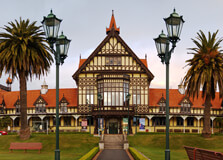
Rotorua Museum of Art and History
The Rotorua Museum of Art and History is a significant cultural landmark in Rotorua, New Zealand. It is located in the historic Bath House building in the Government Gardens and is well known for showcasing the region’s rich Māori culture, geothermal history, and artistic heritage. How to Reach Rotorua Museum of Art and History The museum is centrally located in Rotorua and can be easily reached by: By Car: The museum is located in the Government Gardens, within a short drive from most Rotorua accommodations. Parking is available nearby. By Public Transport: Local bus services stop near the Government Gardens, making it convenient for visitors without private transport. By Walking: If staying in the city center, the museum is within walking distance from many hotels and attractions. Weather and Best Time to Visit Rotorua has a mild and temperate climate, making it a great place to visit year-round: Spring (September to November): Pleasant weather with blooming flowers in the Government Gardens. Summer (December to February): Warm and busy season, perfect for outdoor activities before or after visiting the museum. Autumn (March to May): Mild temperatures with fewer crowds, making it a peaceful time to explore. Winter (June to August): Cooler weather, ideal for exploring indoor exhibitions without large tourist crowds. Timing of Rotorua Museum The Rotorua Museum is currently closed for earthquake strengthening, but visitors can still explore the exterior and the Government Gardens. Once reopened, the expected hours will be: Monday to Sunday: 9:00 AM – 5:00 PM Why is Rotorua Museum Famous? The Rotorua Museum is famous for its stunning Tudor-style architecture, its extensive collection of Māori cultural artifacts, and its exhibitions on the geothermal history of Rotorua. It is housed in one of New Zealand’s most iconic buildings, the former Bath House, which was once a spa facility for therapeutic treatments. Entry and Visit Details Currently, the museum remains closed for renovations, but entry details will be updated once it reopens. Before closure, general admission fees applied, with discounts for children, students, and seniors. History and Architecture of Rotorua Museum The museum building was originally constructed in 1908 as a Bath House, offering therapeutic treatments using Rotorua’s geothermal waters. The Tudor-style architecture, with its grand design and picturesque setting, makes it one of the most photographed buildings in New Zealand. Over the years, it transitioned into a museum to preserve and showcase Rotorua’s rich cultural and historical heritage. Things to Do at Rotorua Museum Explore the Government Gardens: Even with the museum closed, visitors can enjoy the beautifully maintained gardens surrounding the building. Learn About Māori Culture: Before closure, the museum had excellent exhibitions on Māori traditions, art, and history. Photography: The historic building and gardens provide stunning photo opportunities. Attend Events: Occasionally, events and exhibitions are held in the gardens or surrounding area. Interesting Facts About Rotorua Museum The building was originally designed as a luxurious spa for international visitors in the early 1900s. The museum featured exhibitions on the 1886 Mount Tarawera eruption and the Buried Village. The museum has been closed since 2016 due to structural concerns after an earthquake. It is part of the larger Government Gardens, an area gifted to the people of New Zealand by the local Te Arawa iwi. Tips for Visiting Rotorua Museum Check official updates about the reopening of the museum before visiting. Explore the Government Gardens and nearby attractions like the Polynesian Spa. Join a guided cultural tour in Rotorua to learn more about Māori heritage. Visit the Rotorua i-SITE Visitor Centre for alternative museum experiences in the city.
Explore More
The Christchurch Gondola is one of the city's most famous attractions, offering breathtaking panoramic views of the city, Canterbury Plains, and Lyttelton Harbour. It provides a unique experience, taking visitors on a scenic ride up the Port Hills to the summit station. How to Reach Christchurch Gondola The gondola is located just 15 minutes from Christchurch city center: By Car: Drive to 10 Bridle Path Road, Heathcote Valley. There is free parking available. By Public Transport: Take the Metro Bus route from the city center to Heathcote Valley. By Shuttle: A shuttle service operates from the central city to the gondola base. Weather and Best Time to Visit Christchurch has a temperate climate, making the gondola a great experience year-round: Spring and Summer (September to February): Ideal for clear views and comfortable temperatures. Autumn (March to May): Offers beautiful colors and cool weather. Winter (June to August): Crisp air and the chance to see snow-capped mountains. Timing of Christchurch Gondola The gondola operates daily from: 10:00 AM – 5:00 PM Why is Christchurch Gondola Famous? The Christchurch Gondola is known for its spectacular views, nature walks, and historical exhibits at the summit station. Entry and Visit Details Tickets can be purchased at the base station or online. Prices vary for adults, children, and families. History and Architecture The gondola was opened in 1992 and has since become a major tourist attraction. The summit station includes a time tunnel ride showcasing Canterbury's history. Things to Do at Christchurch Gondola Enjoy Panoramic Views: See the city, mountains, and ocean from the top. Visit the Time Tunnel: An interactive exhibit about Christchurch’s history. Hiking and Walking: Explore scenic trails from the summit. Dining: The summit café offers great food with stunning views. Photography: Capture breathtaking landscapes from various lookout points. Interesting Facts About Christchurch Gondola The gondola ride covers a distance of 862 meters. The summit station sits 445 meters above sea level. It offers a 360-degree view of Christchurch and its surroundings. Tips for Visiting Christchurch Gondola Check the weather forecast for the best visibility. Arrive early to avoid long queues. Wear warm clothing, especially in winter. Bring a camera to capture stunning scenery.
Explore More7 Nights - 8 Days New Zealand Package
8 Days/ 7 Night
Auckland - Christchurch - Rotorua - Queenstown
6 Nights - Untouched South New Zealand Tour
7 Days/ 6 Night
Milford Sound - Christchurch - Queenstown
Amazing Australia - New Zealand 15 Days Tour Package
15 Days/ 14 Night
Sydney - Cairns - Melbourne - Auckland - Christchurch - Rotorua - Queenstown
Amazing New Zealand 7N - 8D Package
8 Days/ 7 Night
Auckland - Christchurch - Rotorua - Queenstown
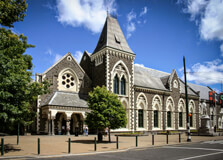
The Canterbury Museum is one of Christchurch’s most significant cultural landmarks, showcasing a vast collection of historical artifacts, natural history exhibits, and Maori heritage. Located in the heart of the city, it offers visitors an in-depth look at New Zealand’s rich past. How to Reach Canterbury Museum, Christchurch The museum is easily accessible from various parts of Christchurch: By Car: Located at Rolleston Avenue, parking is available nearby. By Public Transport: Several bus routes pass close to the museum. By Foot: Situated in the central city, it is within walking distance from many attractions. Weather and Best Time to Visit Christchurch has a mild climate, making the museum a great year-round attraction: Spring and Summer: Warmer months are ideal for exploring both the museum and surrounding Botanic Gardens. Autumn and Winter: A perfect indoor activity during colder weather. Timing of Canterbury Museum The museum is open daily from: 9:00 AM – 5:30 PM (Summer) 9:00 AM – 5:00 PM (Winter) Why is Canterbury Museum Famous? The Canterbury Museum is renowned for its extensive collection of exhibits related to New Zealand’s natural and cultural history. It houses rare Maori artifacts, Antarctic exploration memorabilia, and fascinating displays about early settlers. Entry and Visit Details Entry to the Canterbury Museum is free, but donations are appreciated. Special exhibitions may have separate charges. History and Architecture Founded in 1867, the museum is housed in a beautiful heritage building featuring Gothic Revival architecture. It has undergone several renovations to preserve its historical charm while integrating modern exhibit spaces. Things to Do at Canterbury Museum Explore Maori and Pacific Collections: Learn about indigenous history and culture. Visit the Antarctic Exhibit: Discover the legacy of early Antarctic explorers. Walk Through Christchurch Street: A fascinating recreation of early Christchurch. Interactive Kids’ Area: A fun space for children to learn and play. Photography Opportunities: Capture the stunning architecture and displays. Interesting Facts About Canterbury Museum Holds one of the most extensive collections of Antarctic exploration relics. Features an entire floor dedicated to Maori and Polynesian culture. Home to a replica of a 19th-century Christchurch street. Tips for Visiting Canterbury Museum Visit early to explore at a relaxed pace. Check for temporary exhibitions for unique displays. Take a guided tour for deeper insights into the collections. Combine your visit with a walk in the nearby Botanic Gardens.
Explore More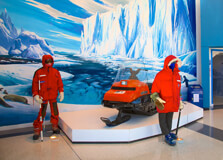
International Antarctic Centre
The International Antarctic Centre in Christchurch is a world-renowned attraction that offers visitors an immersive experience into the icy landscapes and fascinating wildlife of Antarctica. Located near Christchurch Airport, this center provides interactive exhibits, thrilling rides, and real-life encounters with Antarctic animals. How to Reach International Antarctic Centre, Christchurch The center is conveniently located near the airport, making it easy to access: By Car: Located at 38 Orchard Road, just a 5-minute drive from Christchurch Airport and about 15 minutes from the city center. Free parking is available on-site. By Public Transport: Bus routes, including the Purple Line, connect the city center to the International Antarctic Centre. By Taxi or Rideshare: Taxis and rideshare services provide quick and easy access to the center. Weather and Best Time to Visit Christchurch has a mild oceanic climate, making the International Antarctic Centre a great destination year-round. Since it is an indoor attraction, visitors can enjoy it in any season. Timing of International Antarctic Centre The center is open daily with the following timings: 9:00 AM – 5:30 PM (last entry at 4:30 PM) Special holiday hours may apply, so checking the official website before visiting is recommended. Why is International Antarctic Centre Famous? The International Antarctic Centre is known for its unique attractions and experiences: Antarctic Storm Experience: Feel the extreme temperatures of an Antarctic storm inside a specially designed room. Hägglund Ride: Experience an exciting ride in an all-terrain Antarctic vehicle. Little Blue Penguins: Observe rescued penguins in a natural habitat setting. 4D Theatre: Enjoy an immersive Antarctic adventure with special effects. Entry and Visit Details Admission prices vary depending on the experience package chosen: Adults: Approximately NZD 49 Children (5-15 years): NZD 29 Family passes and combo tickets with other attractions are available. History and Architecture Opened in 1992, the International Antarctic Centre was designed to educate and entertain visitors about Antarctic exploration and wildlife. The center features modern architecture with interactive displays, multimedia exhibits, and simulated environments. Things to Do at International Antarctic Centre Antarctic Storm Room: Experience the chill of a real Antarctic storm. Penguin Encounter: Watch little blue penguins up close. Hägglund Ride: Take a thrilling ride in an Antarctic transport vehicle. 4D Theatre: Enjoy a dynamic Antarctic adventure movie. Exhibits and Displays: Learn about Antarctic history, wildlife, and research. Interesting Facts About International Antarctic Centre It is one of the few places in the world where visitors can experience an Antarctic storm indoors. The center houses rescued little blue penguins that cannot survive in the wild. Christchurch serves as a major gateway to Antarctica for scientific research missions. Tips for Visiting International Antarctic Centre Wear warm clothing, especially for the Antarctic Storm experience. Visit in the morning to avoid crowds and enjoy all activities at a relaxed pace. Check for combo deals if you plan to visit other Christchurch attractions. Don’t miss the feeding time at the penguin exhibit.
Explore More
Quake City is a must-visit attraction in Christchurch, dedicated to the powerful earthquakes that have shaped the city’s recent history. This interactive museum tells the story of Christchurch’s resilience and recovery following the devastating 2010 and 2011 earthquakes. How to Reach Quake City, Christchurch Quake City is located in the heart of Christchurch and is easily accessible: By Car: Situated at 299 Durham Street North, Christchurch, with parking available nearby. By Public Transport: Several bus routes stop close to the museum. By Foot: If you are in the central city, Quake City is within walking distance of major attractions. Weather and Best Time to Visit Christchurch experiences a temperate climate with warm summers and cool winters. Quake City is an indoor museum, making it an ideal destination year-round. Timing of Quake City The museum is open daily with the following hours: 10:00 AM – 5:00 PM Closed on Christmas Day Why is Quake City Famous? Quake City is renowned for its powerful storytelling and exhibits, which highlight the impact of the earthquakes and Christchurch’s rebuilding efforts. Key attractions include: Personal Stories: Hear firsthand accounts from survivors and rescuers. Structural Artifacts: View remains of Christchurch Cathedral and other historic buildings. Educational Exhibits: Learn about seismic activity and earthquake engineering. Entry and Visit Details Admission fees for Quake City: Adults: Approximately NZD 20 Children (under 15): NZD 8 Family passes and group discounts available. History and Architecture Quake City was established as part of the Canterbury Museum and serves as an educational center documenting the impact of the 2010 and 2011 earthquakes. The exhibits are designed with modern and interactive elements to engage visitors of all ages. Things to Do at Quake City Explore the Exhibits: Learn about the science behind earthquakes. Watch Documentary Footage: See real-life footage of the earthquakes and recovery efforts. Engage with Interactive Displays: Understand how buildings are designed to withstand seismic activity. Interesting Facts About Quake City The museum displays twisted metal from the Cathedral’s spire. Visitors can experience a simulated earthquake. The exhibit features stories of heroism and community spirit. Tips for Visiting Quake City Allow at least an hour to explore the exhibits thoroughly. Visit early to avoid crowds. Combine your visit with other nearby attractions in central Christchurch.
Explore More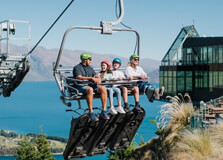
The Skyline Gondola in Queenstown is one of the most famous attractions in New Zealand, offering breathtaking panoramic views of Queenstown, Lake Wakatipu, and the surrounding mountain ranges. This scenic cable car ride takes visitors up to Bob’s Peak, where a variety of exciting activities await. How to Reach Skyline Gondola, Queenstown The Skyline Gondola is conveniently located in the heart of Queenstown: By Car: The base station is located at Brecon Street, Queenstown. Paid parking is available nearby. By Foot: A short 5-10 minute walk from central Queenstown. By Public Transport: Local buses and shuttles provide easy access to the gondola base. Weather and Best Time to Visit Queenstown experiences a mix of weather conditions throughout the year. Summer (December to February) offers clear skies and warm temperatures, while winter (June to August) provides a snowy landscape. The Skyline Gondola operates year-round, making any season a good time to visit. Timing of Skyline Gondola The Skyline Gondola operates daily with the following schedule: Opening hours: 9:00 AM – 9:00 PM Check the official website for seasonal variations and special event closures. Why is Skyline Gondola Famous? The Skyline Gondola is renowned for its stunning views and thrilling activities: Panoramic Views: Enjoy breathtaking views of Queenstown and its surroundings. Adventure Activities: Try the Skyline Luge, mountain biking, and ziplining. Dining with a View: Experience fine dining at the Stratosfare Restaurant and Bar. Stargazing: Participate in guided stargazing tours at night. Entry and Visit Details Admission prices vary based on activities included: Gondola Ride: Approx. NZD 46 for adults, NZD 32 for children. Luge Packages: Additional charges apply based on the number of rides. Combo Tickets: Available for dining and adventure activities. History and Architecture The Skyline Gondola has been a major Queenstown attraction since its establishment in 1967. The gondola system has undergone upgrades to provide a safer and more comfortable ride. The viewing decks and restaurant feature a modern architectural design, enhancing the overall experience. Things to Do at Skyline Gondola Skyline Luge: Ride down winding tracks with stunning views. Mountain Biking: Explore thrilling downhill bike trails. Hiking Trails: Enjoy scenic walks and hikes around Bob’s Peak. Stratosfare Restaurant: Dine with a view at one of Queenstown’s best restaurants. Stargazing: Take part in guided night tours to explore the night sky. Interesting Facts About Skyline Gondola It is the steepest cable car lift in the Southern Hemisphere. The luge track was designed by a former Olympic luger. The viewing deck offers a 220-degree panorama of Queenstown. Tips for Visiting Skyline Gondola Book tickets online in advance to avoid long queues. Visit during sunset for spectacular views. Dress warmly in winter for a comfortable experience. Take a camera to capture the stunning landscapes.
Explore More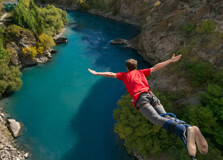
Kawarau Bridge is one of the most iconic landmarks in Queenstown, New Zealand. It is widely known as the birthplace of commercial bungy jumping, attracting thrill-seekers from around the world. The bridge spans the stunning Kawarau River and offers breathtaking views of the surrounding landscapes. How to Reach Kawarau Bridge, Queenstown Kawarau Bridge is easily accessible from Queenstown: By Car: The bridge is located about 20 minutes from Queenstown along State Highway 6. Parking is available near the site. By Bus: Several tour operators and shuttle services run from Queenstown to the bridge. By Taxi or Rideshare: Taxis and rideshare services offer a convenient option for visitors. Weather and Best Time to Visit Queenstown has a temperate climate, making Kawarau Bridge a great attraction to visit year-round. Summer (December to February) offers warm temperatures, while winter (June to August) provides a scenic snow-covered backdrop. Timing of Kawarau Bridge The bridge is accessible at all times; however, bungy jumping operates daily: 9:30 AM – 4:30 PM (hours may vary seasonally) It is recommended to check the official website for updated schedules. Why is Kawarau Bridge Famous? Kawarau Bridge is renowned for several reasons: Bungy Jumping: It is the world's first commercial bungy jumping site, operated by AJ Hackett Bungy. Scenic Views: The bridge offers incredible views of the Kawarau River and surrounding mountains. Adventure Tourism: It is a must-visit destination for adrenaline seekers in New Zealand. Entry and Visit Details Visiting the bridge is free, but activities like bungy jumping have costs: Bungy Jumping: Starts from approximately NZD 205 per person. Tandem Bungy: Available for those who want to jump with a partner. Bridge Viewing: Free for visitors who want to watch the jumpers. History and Architecture Built in 1880, Kawarau Bridge was originally part of the main road connecting Queenstown to the Otago Goldfields. The bridge has a distinctive suspension design and has since become a historic and adventure hotspot. Things to Do at Kawarau Bridge Bungy Jumping: Experience an exhilarating 43-meter freefall into the Kawarau River. Ziplining: Enjoy an exciting zip ride across the river. Photography: Capture stunning views of the bridge and river. Spectator Viewing: Watch daring jumpers take the plunge. Interesting Facts About Kawarau Bridge It was the world's first commercial bungy site, opened in 1988. The bridge is 43 meters high, offering a thrilling drop into the river below. AJ Hackett Bungy has operated the site for over 30 years. Tips for Visiting Kawarau Bridge Book bungy jumps in advance to secure your preferred time slot. Wear comfortable clothing and secure loose items before jumping. Even if you're not jumping, the bridge is worth visiting for its scenery and history.
Explore More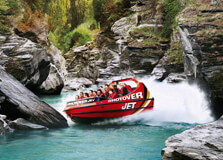
The Shotover River Jet Boat Ride in Queenstown is one of New Zealand’s most thrilling adventure activities. This high-speed jet boat ride takes you through the narrow canyons of the Shotover River, offering adrenaline-pumping twists and turns while showcasing stunning natural scenery. How to Reach Shotover River Jet Boat Ride, Queenstown Reaching the Shotover River Jet Boat Ride is easy, as it is located close to Queenstown’s town center: By Car: Located about 7 km from Queenstown, it takes around 10 minutes to drive to the Shotover Jet base. By Shuttle: The operator provides shuttle services from Queenstown, making it convenient for tourists. By Taxi or Rideshare: A quick and hassle-free way to reach the site. Weather and Best Time to Visit Queenstown experiences four distinct seasons, making the jet boat ride an enjoyable experience all year round: Summer (December - February): Warm and sunny, ideal for water adventures. Autumn (March - May): Mild temperatures with beautiful golden landscapes. Winter (June - August): Chilly but exhilarating, as the surrounding mountains are covered in snow. Spring (September - November): Fresh and vibrant, a perfect time for outdoor fun. Timing of Shotover River Jet Boat Ride The jet boat ride operates daily: Opening hours: 9:00 AM – 6:00 PM Rides run frequently throughout the day. Booking in advance is recommended, especially during peak tourist seasons. Why is Shotover River Jet Boat Ride Famous? The Shotover Jet is world-famous for its thrilling experience and breathtaking scenery: Extreme Speed: Boats travel at speeds of up to 85 km/h. 360-Degree Spins: Skilled drivers perform spectacular spins and maneuvers. Narrow Canyons: The ride navigates through the dramatic Shotover River canyons. Exclusive Access: The only jet boat operator allowed to operate in the Shotover River canyons. Entry and Visit Details Tickets and entry details: Adults: Approximately NZD 159 Children (5-15 years): NZD 89 Family packages and group discounts available. History and Architecture The Shotover Jet began in 1965 and has since become one of New Zealand’s top adventure attractions. The high-powered jet boats are specifically designed to navigate the river’s shallow waters and narrow canyons. Things to Do at Shotover River Jet Boat Ride Jet Boat Ride: Experience the thrill of high-speed spins and narrow canyon runs. Scenic Photography: Capture stunning landscapes and the dramatic Shotover River. Explore Nearby Areas: Visit nearby trails, rivers, and adventure parks. Other Adventure Activities: Try bungee jumping, rafting, or canyon swings in the Queenstown area. Interesting Facts About Shotover River Jet Boat Ride The Shotover Jet has been thrilling visitors for over 50 years. Over 4 million people have experienced the ride since its inception. The ride covers a stretch of 7 km along the Shotover River. Famous personalities, including members of the British royal family, have enjoyed the ride. Tips for Visiting Shotover River Jet Boat Ride Wear warm clothing and sunglasses to protect against wind and water spray. Book tickets online in advance to secure your preferred time slot. Arrive at least 30 minutes before your scheduled ride for check-in and safety briefing. Hold on tightly and enjoy the thrill!
Explore More